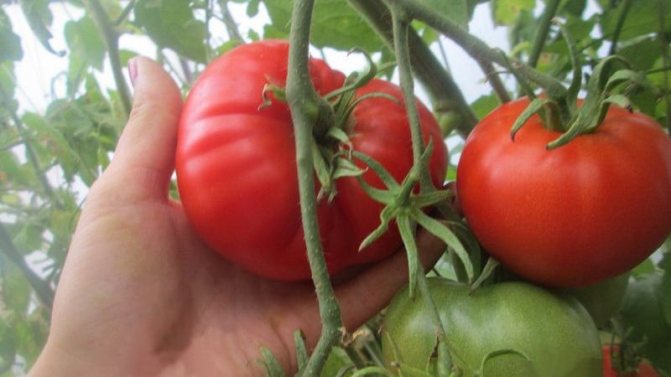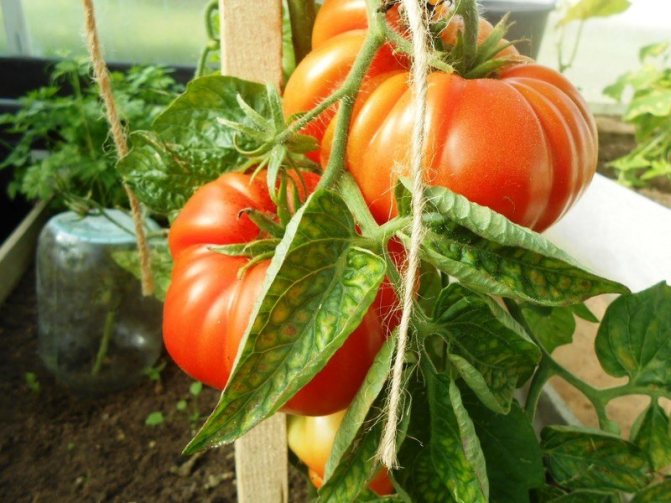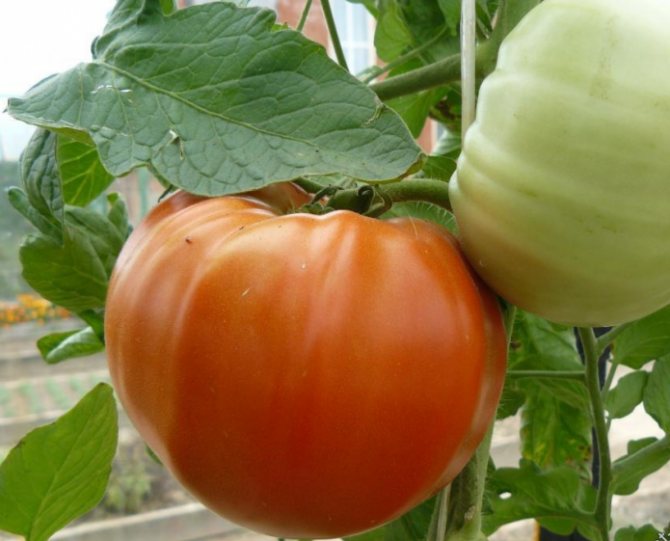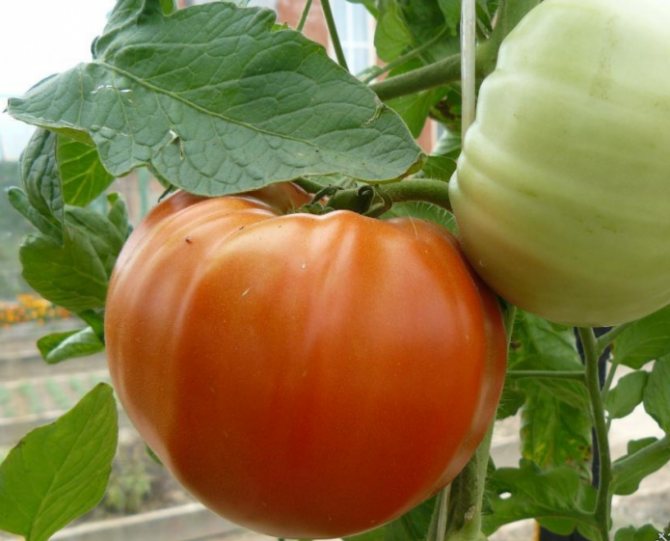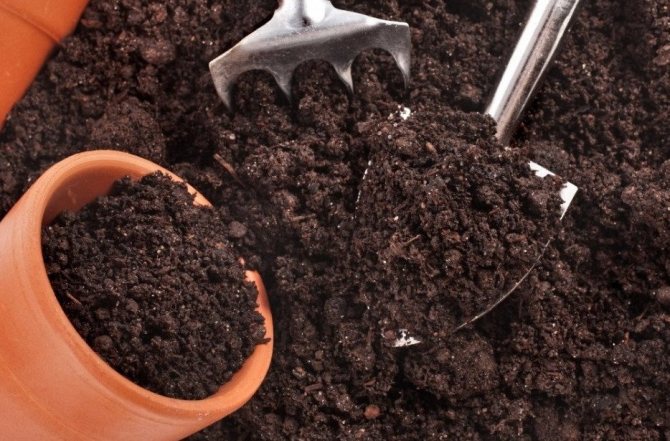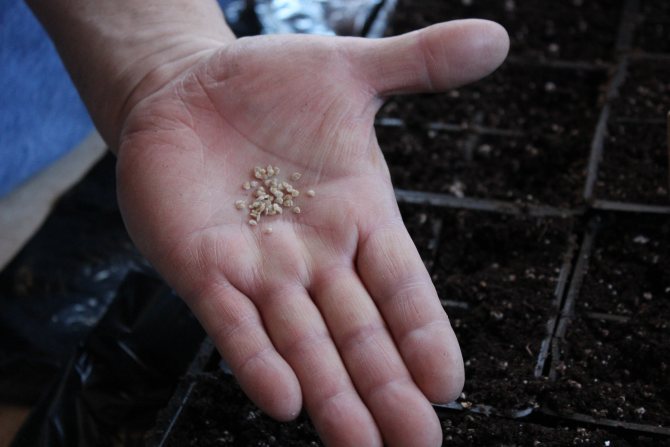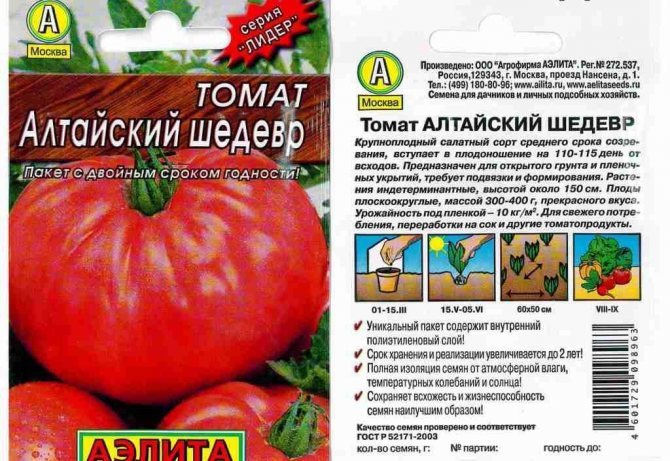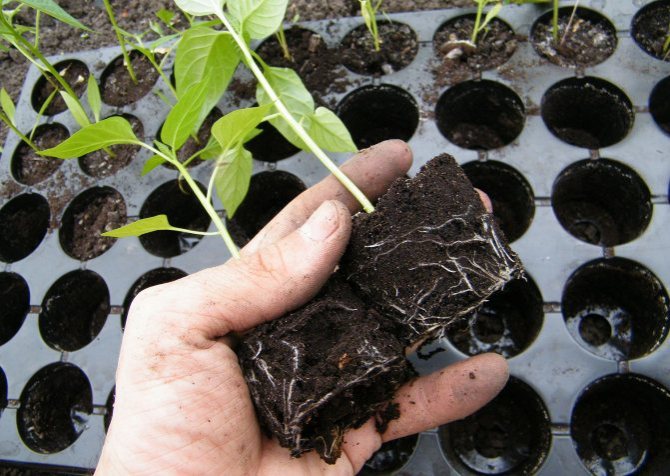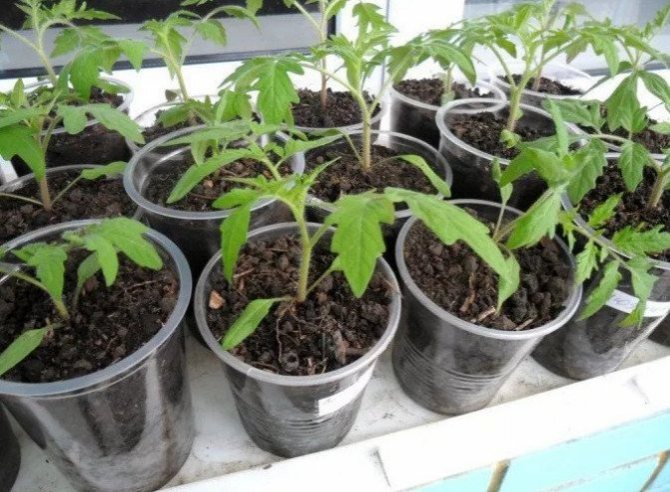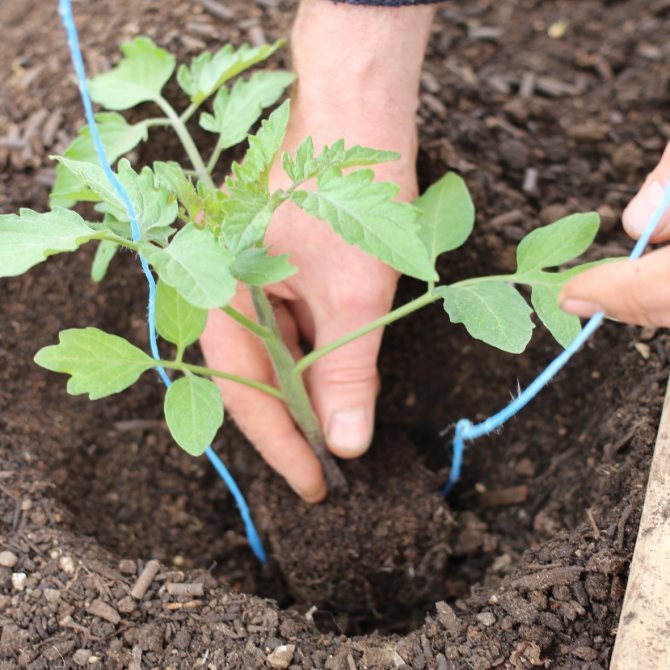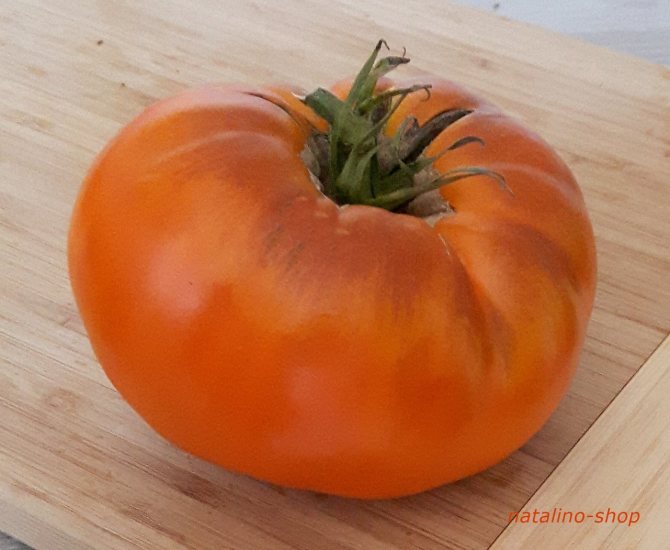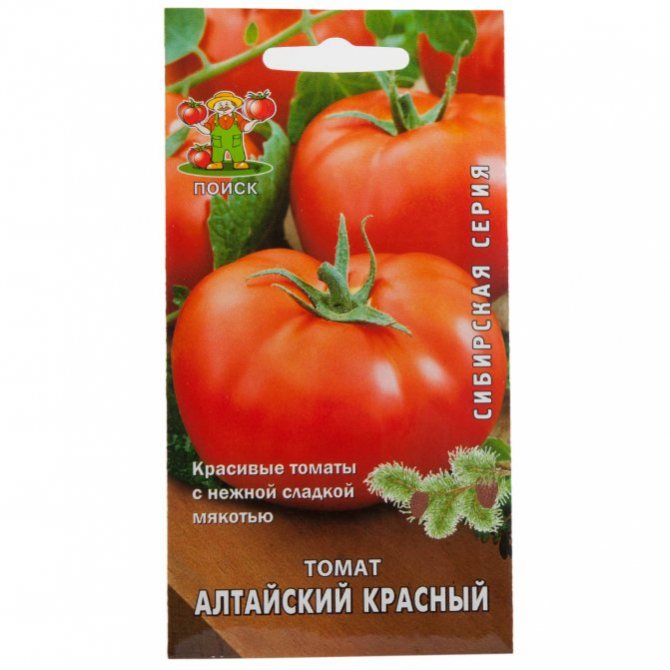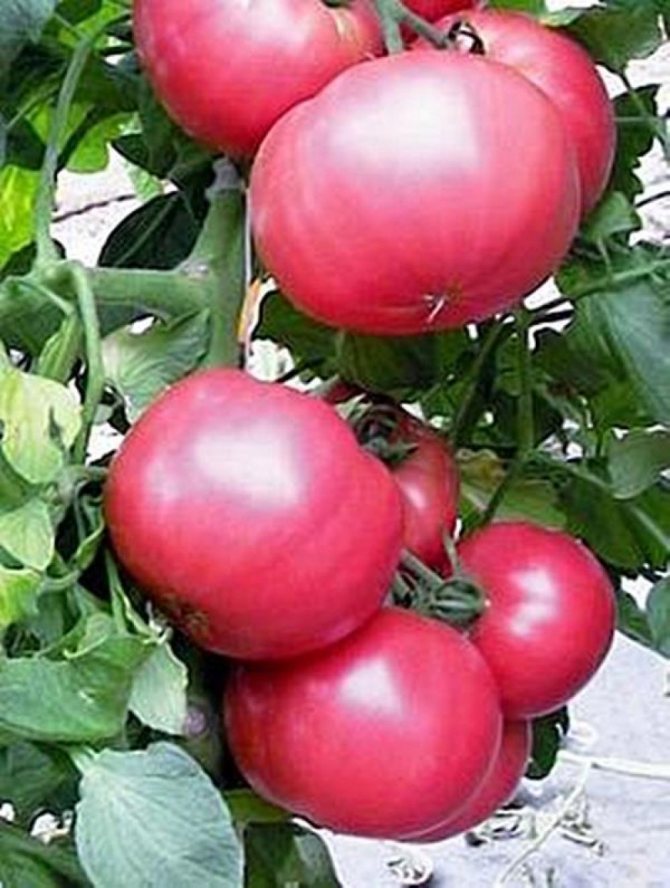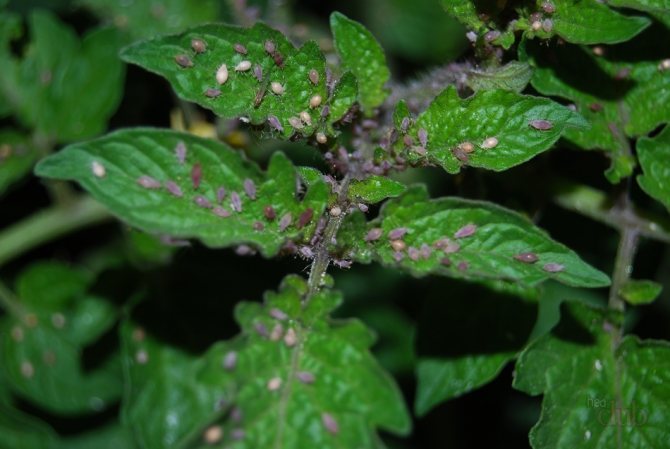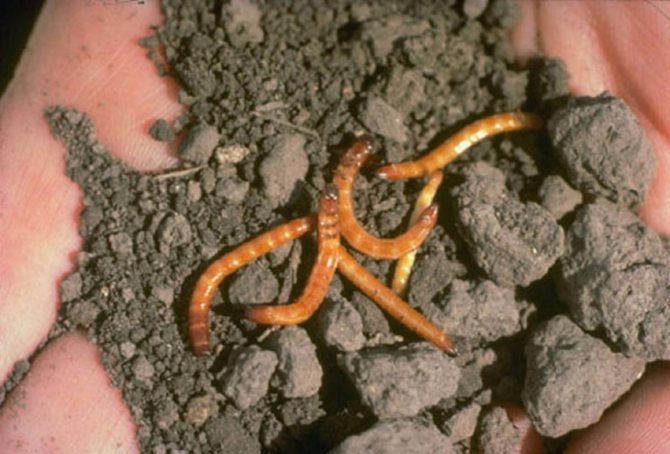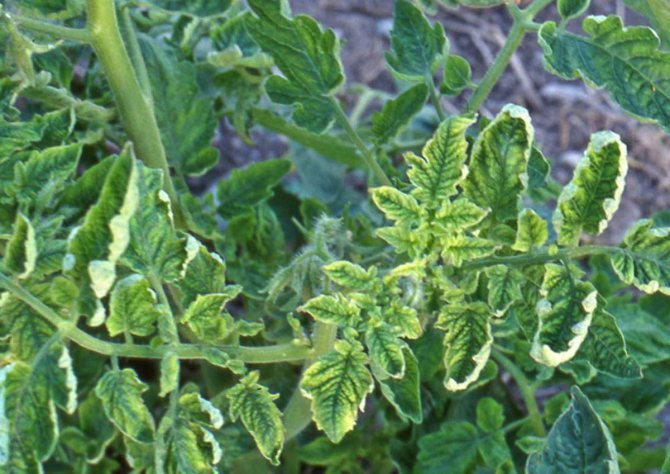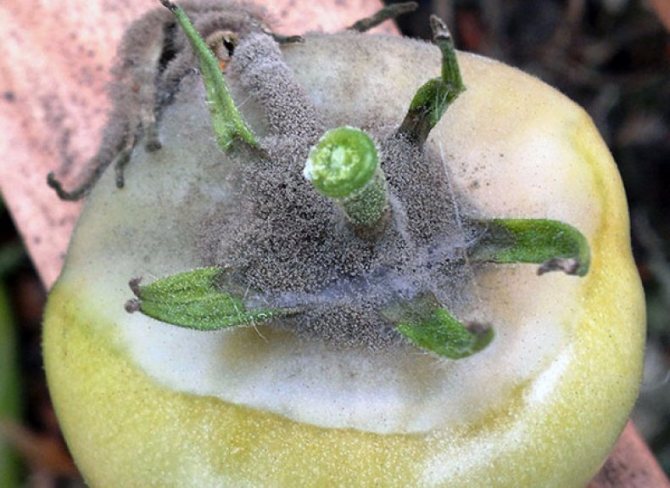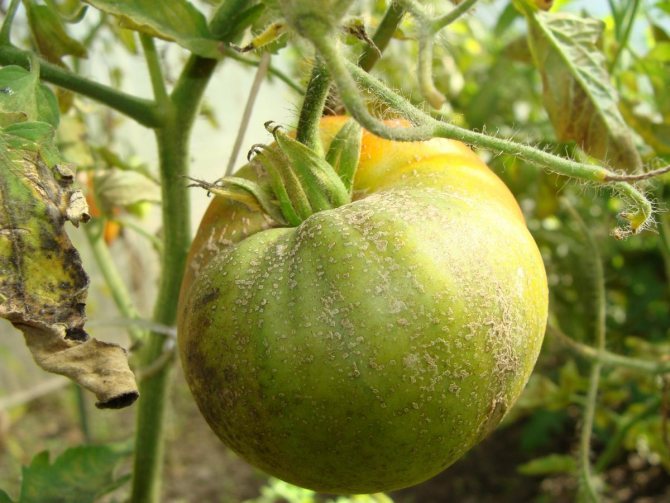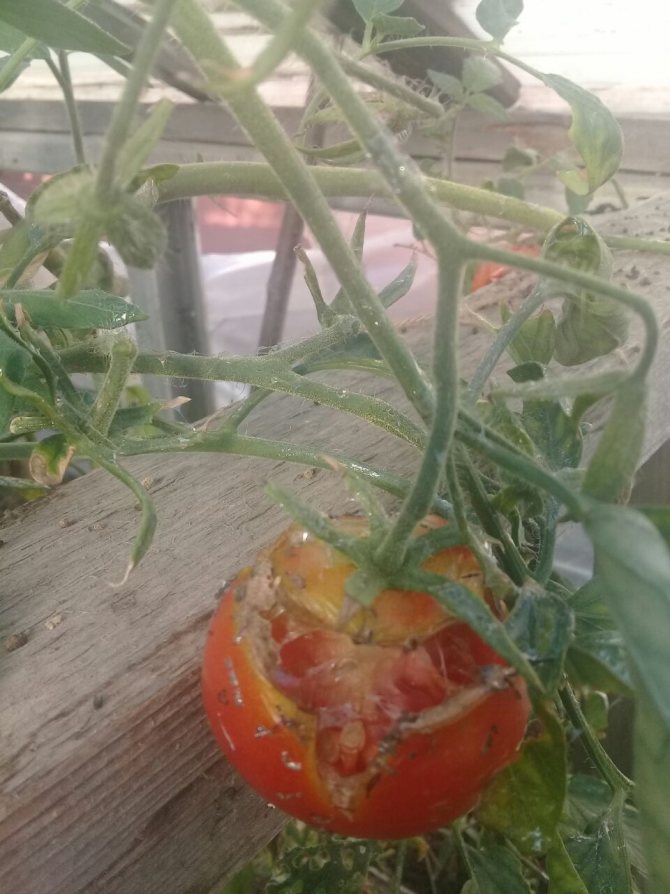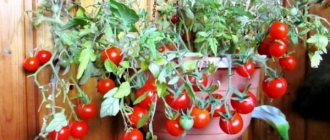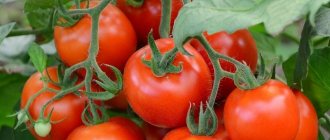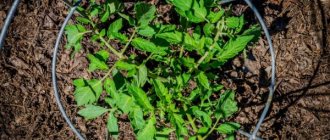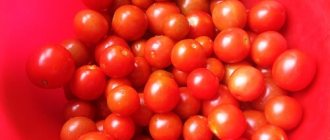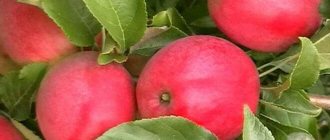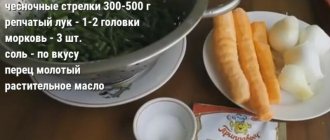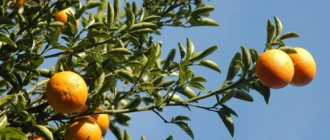»Vegetable growing» Tomatoes »Tomato variety Altai masterpiece
0
211
Article rating
In the changing northern climate, it is not easy to grow a good harvest of tomatoes. The new frost-resistant tomato Altai masterpiece demonstrates excellent performance. This plant is distinguished by its high taste, immunity to fungal diseases and ease of care.
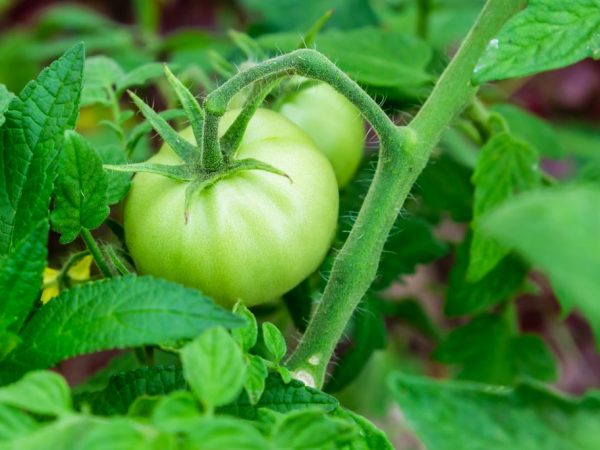
Tomato variety Altai masterpiece
Positive qualities and disadvantages of the glorious Siberian variety
Everyone knows the famous expression about a boat, which, as you name it, will sail so. The story is exactly the same with tomatoes, because it is not so easy to give out names to varieties. So the Altai masterpiece can rightfully be called a work of art, or rather, the achievement of a very difficult selection work.
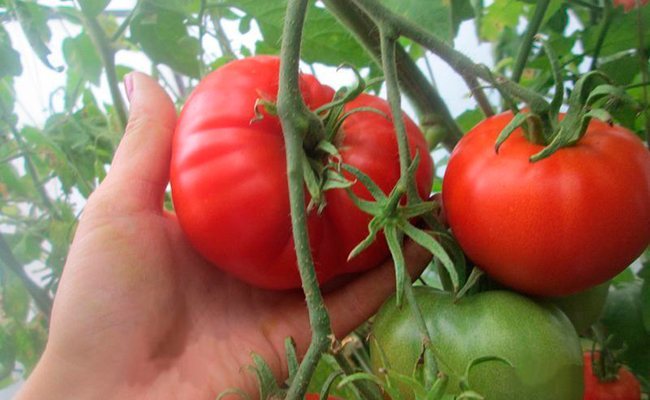

Have questions? Ask and get useful advice from professional gardeners and experienced summer residents. Ask a question >>
Meet the vast family of Altai tomatoes
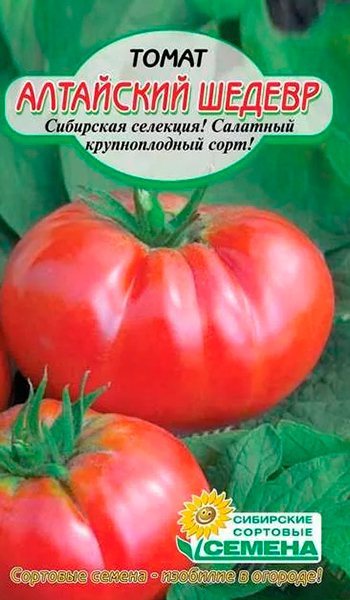

A large and tasty Altai masterpiece is often confused with other varieties of tomatoes, the names of which also contain the name of the region - Altai. And in order to avoid confusion, we decided to review different varieties and hybrids of the Siberian series.
There is a line of tomatoes, united by the name Altai, but different in color. These are the best varieties of tomatoes of Siberian selection, the pride of breeders.
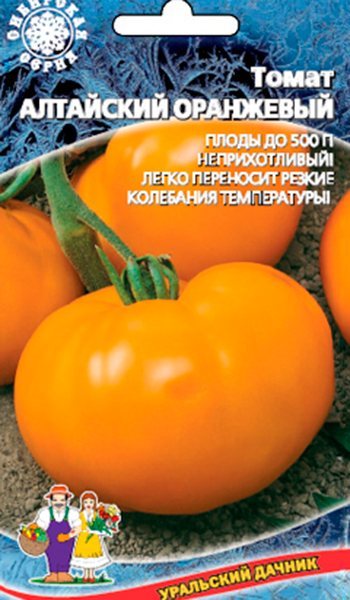

So, lettuce Altai pink is distinguished by long-term fruiting, and its tomatoes are large, with an average weight of up to 500 grams. To match him and Altai red, Altai orange - varieties with large fruits, excellent taste. They are used for salads, as well as processing into juices and sauces.
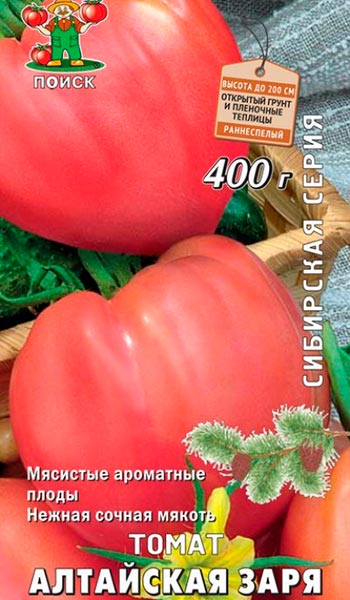

Agro offers a mid-season tomato Altai Strongman - a large, salad variety, about which there are only positive reviews. He grows tomatoes weighing up to half a kilogram, red, very dense and fleshy. Tomatoes have similar characteristics. Heavyweight of Siberia. For salads and processing, the Altai Zarya variety is suitable, the fruits of which have a beautiful heart-shaped shape and raspberry color. The mass of tomatoes is up to 600 grams.
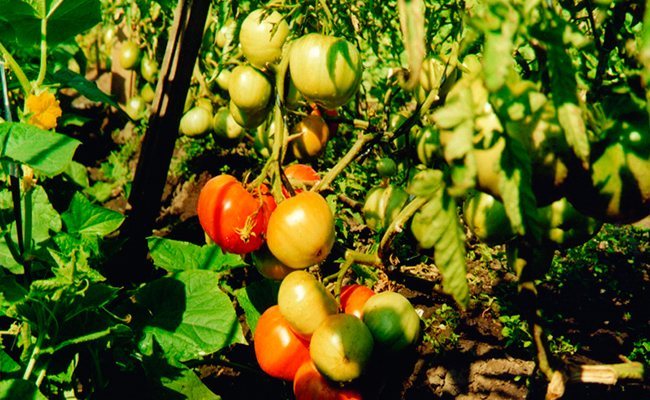

It will take only 90 days to start removing small tomatoes of the Altai Early variety. Its fruits are not as large as those of the tomatoes listed above, by weight - about 120-150 grams. But on the other hand, he "overtakes" them in terms of ripening, and tomatoes are great for conservation.
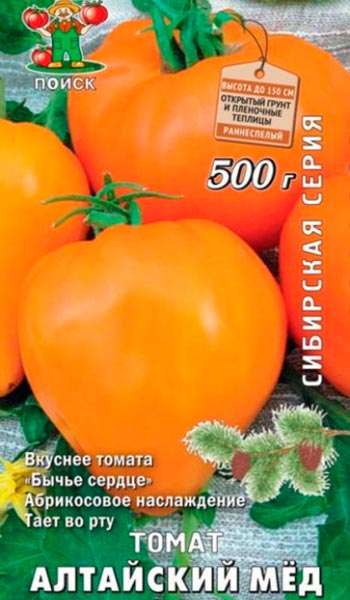

The Altai surprise variety also has large fruits (see the photo), but the orange Altai honey is even called “apricot delight”. Its heart-shaped fruits have a bright orange color and an amazing honey taste.
The origin of the tomato variety "Altai masterpiece"
As mentioned above, the variety was bred by Siberian breeders. In the State Register of Russia "Altai Masterpiece" appeared in 2007, its originator is "Demetra-Siberia".
| Variety name | Altai masterpiece |
| general description | Mid-season indeterminate variety |
| Originator | Russia |
| Ripening period | 110-115 days |
| The form | Flat-round with well-defined ribbing |
| Color | Red |
| Average weight of tomatoes | 400-500 grams |
| Application | Salad variety |
| Variety yield | 10 kgs sq.m |
| Growing features | Requires pinning |
| Disease resistance | Very resistant to disease |
This powerful indeterminate plant is not a hybrid, i.e. there is no need to buy seeds annually (you can collect your own). It is often confused with Altai Red or Pink, but they are all different types. The bush is not a standard bush, it grows up to 1.8-2 m and higher. The variety is mid-season, from the moment the first shoots appear until the fruits ripen, 110-115 days pass.
It is not demanding in care, but it needs proper shaping, pinning and garter. The leaves are large, light green, the inflorescence is simple. It is better to form a bush in 1 stem. The first inflorescence begins to grow over 10-11 leaves, and the next - after 3 leaves.
The Altai masterpiece is resistant to many diseases of tomatoes in greenhouses, perfectly withstands temperature extremes. Due to its tallness, it is better suited for growing in a greenhouse, but it may well grow in the open field.
Tomatoes are quite large, have a bright red color and are flat-round in shape with large, well-defined ribs. The average weight is 400-500 grams, and in greenhouse conditions it can even reach 1 kg. The pulp is very tasty, fleshy, sweet, medium-dense. The number of chambers is from 6 or more, the dry matter content is about 5-6%. When ripe, the fruits do not crack. Tomatoes tolerate long-term transportation well and are well stored.
We bring to your attention a few more useful and informative articles about
growing tomatoes
.
Read all about indeterminate and determinant varieties, as well as tomatoes that are resistant to the most common nightshade diseases.
On the bush during the season, 4-6 brushes with ovaries have time to form. On each of them 3-5 flat-round, strongly ribbed fruits are formed, the weight of which ranges from 200 to 400 g. With special care, the gardener can get record-breaking berries weighing about 500-800 g. Some tomatoes of this variety even reached 1 kg.
The skin is thin, but tomatoes rarely crack, even with excessive soil moisture. They are well stored in ripe form and do not lose their presentation within 1-1.5 weeks. Strong tomatoes are easy to transport when slightly unripe. The color of the tomato is bright red, in technical ripeness it is light green with a dark spot at the base of the fruit.
The characteristic and description of the variety, according to gardeners' reviews, especially note the taste advantages of the Altai masterpiece tomatoes. As a variety of beef tomatoes, tomatoes have a fleshy flesh with small seed chambers located closer to the walls of the fruit. The color of the flesh is pinkish-red, in the center it may be paler.
The taste is high: tomatoes contain about 6% of dry matter and have a high sugar content. The taste is characterized as sweet with sourness, but acidity can increase in cold rainy seasons. When artificially ripened, tomatoes have a sweet and sour taste and a pronounced characteristic aroma.
Like most beef varieties, the Altai masterpiece is a salad vegetable. It is best consumed fresh. The gradual ripening of berries picked in technical ripeness will provide gardeners with tomatoes until the end of November. Tomato is delicious in salads, can be used to decorate snacks or cuts. In the form of slices, it is suitable for a sandwich and a hamburger.
Surplus products are traditionally processed into juice and sauces. The fleshy pulp produces a thick pulp that requires little boiling. Almost all nutrients and vitamins of fresh tomatoes are preserved in such juice. Bright coloring will make lecho, canned snacks and preparations such as vegetable caviar beautiful. Tomato is not suitable for whole-fruit canning.
The variety is indeterminate, reaching a height of 2 m and more. From the description of tomatoes Altai Masterpiece it follows that you can stop its growth by pinching the top.In a greenhouse, this is done at a level of 180 cm, in open ground conditions - at a level of 150 cm.
The description and photo of the Altai Masterpiece tomato, posted below, confirm the opinions of gardeners that the stem of the variety is strong and thickened, forms a large number of stepchildren. The branches of the bush are powerful, which allows it to withstand the stress of numerous fruits. The leaves are large, light greenish in color. The flowers are arranged in simple racemose inflorescences, which begin to form on the top of the plant above 10-11 leaves and then appear every three leaves. The peduncle is articulated.
Description of fruits
Ripe tomatoes are bright red and have a ribbed structure. The shape is round, slightly flattened. In the process of ripening, the color is light green, a dark mark is located around the stalk, which disappears as the tomatoes develop further. The normal weight of ripe tomatoes is 200-400 g, subject to all agrotechnical measures, this figure can reach 500 g.
The pulp of tomatoes is medium-dense, juicy, fleshy, gives off a powerful pleasant aroma. The dry matter content does not exceed 5-6%. The fruits contain 6 seed chambers. The taste of ripe tomatoes is good, sweet with the presence of sourness.
Reviews of gardeners
Sofia 27
It led in two trunks. Tall, the bush is not frail, but he did not give out many stepsons either. Sowed on February 2, the first ripe fruits - early July (8-10). Long fruiting, in October there were still ripe tomatoes.
Julia
Shook! Really a masterpiece tomato. At the beginning of the season, I fed the tomatoes with Agricola and ASh healed very much. But as a result, it turned out to be a bit late. But very tasty, beautiful and large.
Testimonials
But there are practically no reviews of these tomatoes on the network, which indirectly indicates that they are not very popular with gardeners and gardeners. The reason probably lies in the very narrow specialization of this hybrid tomato: late fruiting combined with almost extreme large-fruited. And good taste, coupled with an interesting appearance, have not yet added popularity to the culture.
It is more correct to classify this hybrid as a collection one: it is intended for those gardeners who love experimenting with new varieties, the formation of plants and obtaining fruits of an unusual size and appearance. And yet it is worth trying: the reward for those who dare to grow a tomato Masterpiece F1 will be a good harvest of delicious and very large tomatoes.
Growing stages
Altai tomatoes are intended for cultivation in regions of risky farming, and therefore seedlings must first be grown.
Seedling care
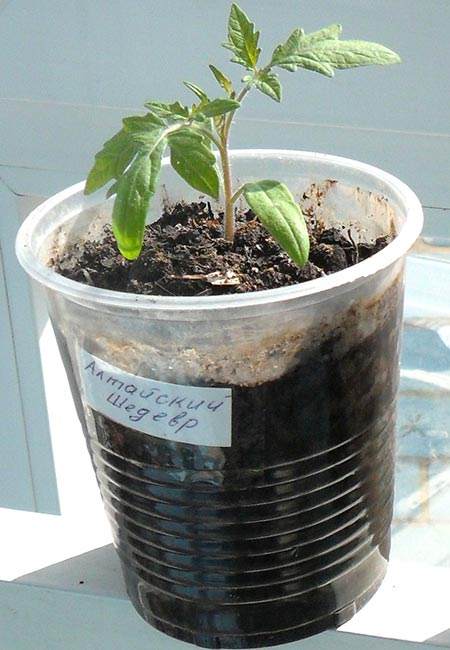

For a start, the seeds undergo pre-sowing treatment:
- disinfection in special formulations (usually potassium permanganate is taken);
- soaking in growth stimulants (aloe juice, ash infusion, purchased preparations Epin or Zircon);
- germination in a damp cloth or gauze.
Prepare boxes, pots, cups in advance, as well as nutritious soil for tomatoes. You can use store-bought formulations (just read the information on the packages carefully), you can prepare the mixture yourself.
Often in stores they offer seedling soil, which consists of one peat. It is impossible to use such soil in its pure form, it is necessary to add sod soil, humus, baking powder (river sand, perlite, vermiculite) to it.
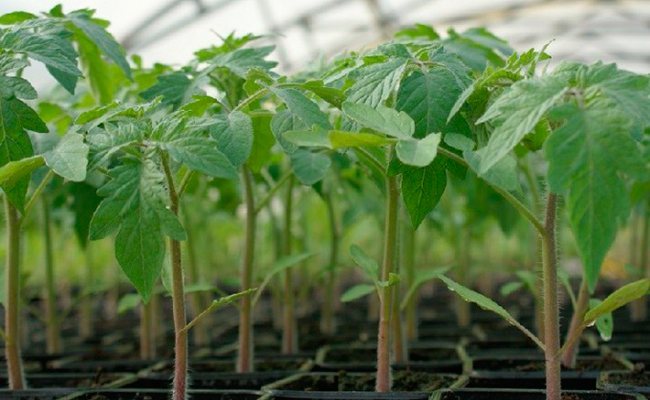

Also add wood ash, superphosphate to the soil mixture. Sowing dates are determined taking into account the time of planting tomatoes in a greenhouse or on ridges, at this point the age of tomatoes should be about 60-65 days. Usually, seeds of this variety are sown for seedlings in March, in order to determine the grown plants in a permanent place in May or early June.
Seedlings growing in boxes dive in separate containers, after about 10-12 days the tomatoes can be fed with Kemira or Agricola.In total, two dressings are carried out for tomatoes growing at home. Watered very sparingly, avoiding excess moisture in the soil.
Growing rules
The Altai Masterpiece tomato variety is grown in seedlings.
Important! Disinfection of tomatoes of the Altai Masterpiece variety is carried out only with the help of solutions of potassium permanganate or boric acid.
Planting seedlings
Seed material is carefully selected and disinfected before sowing. Seeds are harvested from the largest and fully formed tomatoes.
The soil for planting must be saturated with nutrients and sufficiently moist. The seeds are placed in small grooves in the soil mixture and buried by about 3 cm. They are covered with plastic wrap to speed up the seedling formation process. The box with seedlings is rearranged into a warmed and fairly bright room.
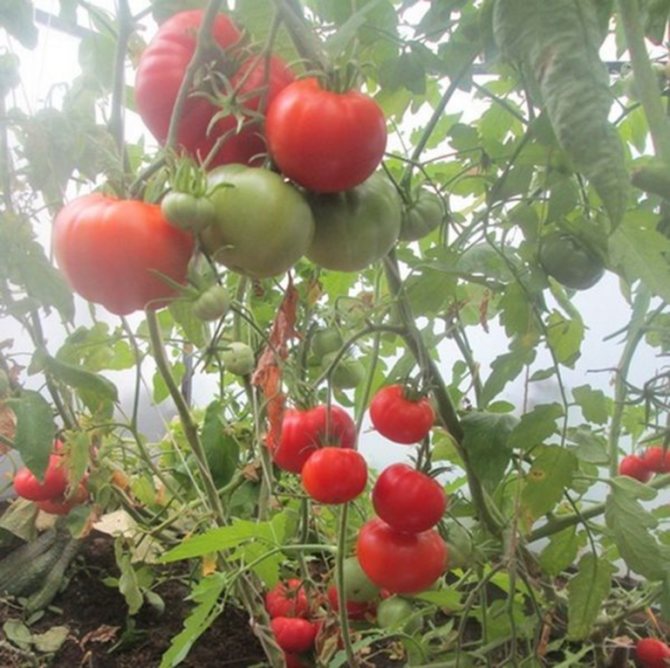

As the first shoots form, the film is removed from the surface of the container and moved to a more suitable place. During this period, seedlings require regular irrigation with settled warm water.
When the Altai Masterpiece of tomato seedlings forms 2-3 true leaves, it is dived and transplanted into separate containers. The need for this procedure is due to the fact that thickened seedlings of seedlings grow worse and are affected by diseases. Young plants need to be regularly turned in different directions to the sun so that the seedlings are not tilted in any direction.
The duration of daylight hours for the Altai Masterpiece tomato variety should be approximately 14 hours. If natural sunlight is not enough, you need to take care of the organization of additional lighting. Usually phytolamps are used for this purpose. It is recommended to install a switched on fan near the tomato seedlings. Artificial wind will make weak stems stronger and stronger.
Two weeks before transplanting to a permanent place, the seedlings begin to harden, which makes it possible to increase their resistance to low temperatures. The containers are taken out into the open air for a certain period of time. The length of time the seedlings stay outside the premises should be short at first, but gradually increase every day.
Tomato transplant
For tomatoes, you need to choose a well-lit area, protected from drafts. The soil should be rich in nutrients and have a light texture.
They switch to transplanting seedlings after the average daily air temperature is stable at 15C, and the soil warms up well enough. The planting scheme is 50 * 40 cm. Plants are buried in the ground by 1/3 of the stem. At first, plantings are protected with a covering material.
Irrigation is carried out every three to four days. Watering frequency may vary depending on weather conditions. Moisture is applied directly under the bush, trying not to get on the stem and foliage, as this will provoke the development of burns. The soil in the bust sector is loosened, which makes it possible to increase the flow of air and moisture to the root system, and also prevents the formation of a dense crust on the soil surface. At the same time, weeds are removed near the tomatoes.
Important! The water should be settled and warm, as the cool liquid inhibits normal root development.
Watering the tomatoes should be optimal. It should not be allowed to overflow or underfill. In the first case, the roots begin to rot, which leads to the development of fungal diseases and plant death. Lack of moisture causes the formation of weak, small, unripe tomatoes.
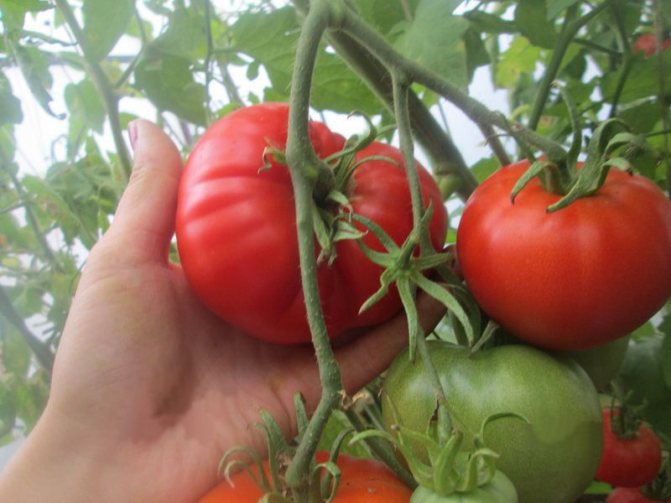

The first introduction of nutrients is carried out before the ovaries are formed on the plants. After that, feeding is repeated every one and a half weeks, using both organic and mineral fertilizers.With an overabundance of nutrients, tomatoes can weaken and become sick. Most often, on tomatoes of the Altai Masterpiece variety, this happens with excessive introduction of nitrogenous substances.
The variety requires tying. This procedure allows the fruit not to sink to ground level and get sick with tomato rot, and also facilitates irrigation. In order to tie up tomato bushes of the Altai Masterpiece variety, the following means are suitable:
- trellis;
- caps;
- stakes 2-2.5 m in height;
- cells.
On tomatoes of the Altai Masterpiece variety, stepchildren must be removed in a timely manner. This will redirect nutrients to the fruit and accelerate ripening. The procedure is carried out simultaneously with the first garter. It is impossible to completely remove the stepsons, you should keep a small stump no more than 1 cm in height. Passionking is carried out until the first inflorescence.
In order for the soil to retain moisture and heat longer and better, it is recommended to cover the soil in the bust sector with a layer of mulch. This procedure will reduce the number of weeds on the site.
How to grow seedlings
Tomato variety Altai masterpiece is grown through seedlings. Seeds are sown at the end of February, after about 60 days, grown and hardened plants are planted in a permanent place of growth. In order for the culture to grow well and bear fruit, vegetable growers follow the rules of agricultural technology.
Seed preparation
The seed must be fresh. Grains are purchased in a specialized store or harvested on their own from their own harvest.
Before sowing, the seeds are placed in a container with salt water for 5-10 minutes (10 g of salt per 1 liter of water). Low-quality grains will float to the surface during this time, they are thrown away. Next, the suitable seed is rinsed in clean water and placed for 20-30 minutes in a 1% potassium permanganate solution, then washed again and sprayed with a growth stimulant, for example, "Kornevin", "Epin" or "Heteroauxin".
To make the seeds hatch faster, two days before sowing, they are laid out on a damp cotton cloth and covered with it. Place in a cool, dark place. The seed tissue is kept moist.
Capacity and soil
The seeds are planted in wooden boxes or special containers. Cropped juice or milk cartons can be used, but most growers grow seedlings in peat tablets or cups. To drain off excess liquid, several holes are made at the bottom of the containers.
Peat products simplify the process of diving plants. The glass, along with the seedlings, is transplanted into large containers. Peat gradually becomes limp and dissolves in the soil, while young plants are not damaged or stressed.
To grow strong seedlings, use high-quality soil:
- most vegetable growers buy ready-made soil mixture for seedlings;
- some prepare the soil on their own by mixing garden soil, humus, sand (sawdust) and wood ash in a 2: 1: 1: 1 ratio.
Before use, the finished soil is disinfected - it is poured abundantly with boiling water or 1% solution of potassium permanganate. This will kill harmful bacteria and pest larvae.
Sowing
Seeds are sown in grooves according to the 3x5 cm scheme. If disposable cups are used, no more than 1-2 grains are planted in one container. Seeds are embedded in the soil 1–1.5 cm, sprinkled with a thin layer of earth and sand, mixed in equal parts.
In order not to erode the soil, the soil is carefully sprayed from the sprayer. For humidification, use settled water at room temperature. Next, the container with seeds is covered with foil or transparent glass and placed in a warm, bright place.
Planting seeds
The Altai masterpiece is grown in seedlings.
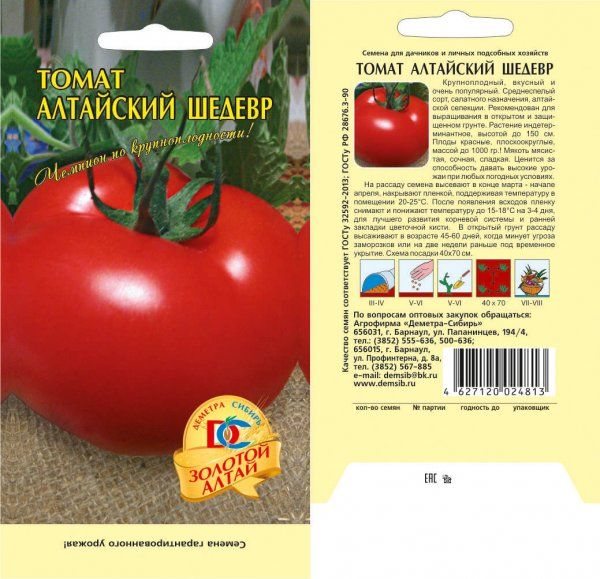

Tomato seeds Altai masterpiece
For planting seeds, it is necessary to carry out pre-sowing treatment. It consists in selection and disinfection seed.
The prepared seeds are planted in moist, nutritious soil, to a depth of 3 cm.For fast germination of seeds, you need to create a micro-greenhouse. Germination will be better if the container with seeds is placed in a warm and bright place.
After the emergence of shoots, the film is removed, the container is rearranged to a place more comfortable for the plant and watering is carried out with warm, settled water.
In the phase of 2-3 true leaves, tomatoes dive in separate pots... In order for the seedlings not to stretch out, due to a lack of light, it is necessary to take care of additional lighting.
14 days before planting in a permanent place, plant needs hardening... This procedure enables young seedlings to adapt better after transplanting.
Garden chores: care features
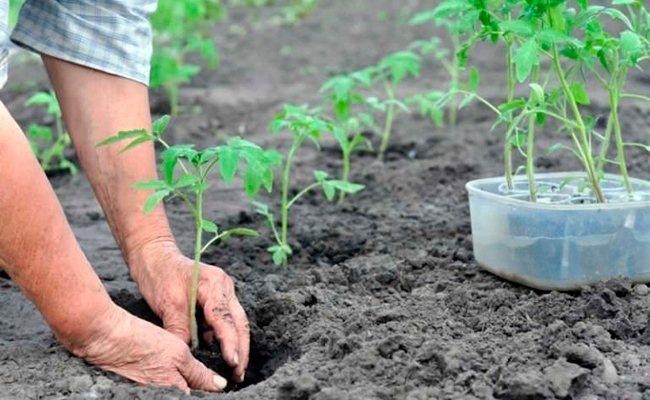

In May or early June, a fruitful tomato is transplanted, while the following should be taken into account:
- the soil should warm up to + 14ºC… + 16ºC;
- seedlings should be strong, with 7-8 leaves, not elongated;
- the weather should be stable and warm outside.
The area should be warm, closed from drafts. The soil is prepared in autumn, carefully digging up and applying the necessary fertilizers (mullein, superphosphate, wood ash).
ON A NOTE! In spring, fresh manure cannot be applied under tomatoes. Only well-rotted compost and humus are allowed.
Since the plants are indeterminate, they must be tied up later. When disembarking, they immediately install racks and ropes for trellises or stakes, which will serve as a support for a tall tomato.
And in the shelter, and even more so on the ridges, tomato seedlings can be covered with covering material for the first time so that they adapt faster.
Further care includes:
- watering;
- loosening;
- bush formation;
- pinching;
- fertilization.
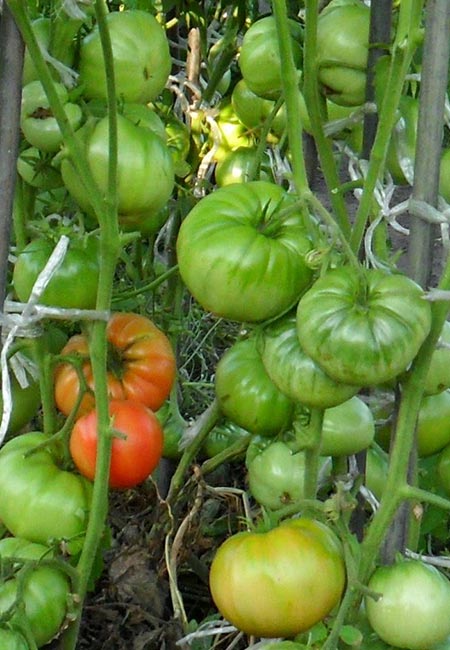

The powerful Altai masterpiece needs abundant, but rare watering. Use warm, + 22ºC water, always settled.
Water should not get on the leaves and shoots of plants, so it is advisable to water them in the holes or grooves.
After watering - loosening the soil, as well as airing the greenhouse. High humidity is bad for tomatoes, and even the most resistant varieties can get sick.
The first feeding is carried out 18-20 days after planting, then every 10 days. Mineral dressings alternate with organic matter, while do not forget to comply with the norm. The plant is usually led into one trunk, removing all lateral shoots.
Features of agricultural technology of tomato Altai masterpiece
Of course, the agricultural technology of tomatoes of this variety is generally the same as that of the whole culture. Here are the basic rules for planting and growing, taking into account the nuances and characteristics of the variety.
Growing seedlings
It is better to purchase seeds for sowing for seedlings from trusted sellers. It is advisable that these seeds are produced and packaged by well-known and reputable producers, for example:
- Agrofirma Aelita;
- "Seeds of Altai";
- "Gavrish";
- "Uralsky Dachnik" and others.
But if the tomatoes turned out to be successful, then in the future it is better to leave a few of the largest and most ripe tomatoes, from which you can collect seeds yourself. In this case, the result will be predictable and always stable.
Since the variety is mid-season, seeds are sown in mid-February, maximum at the beginning of March. Seedlings ready for planting should have a height of about 30 cm and three pairs of true leaves. Typically, for this variety, such conditions occur 55-65 days after the emergence of full shoots.
Transplanting seedlings into the ground
For planting on pre-prepared beds, holes are prepared, in each of which they pour half a bucket of humus and a glass of wood ash. The wells are well spilled with warm water and, after absorbing it, the seedlings are planted, deepening it to the first pair of leaves.
Transplant timing
Seedlings are usually planted in a greenhouse in mid - late April. For open ground, the transplantation dates begin in mid-May for the middle lane and early - mid-June for Siberia and the Urals.
Landing patterns
In the open field, when growing tomatoes in 2-3 stems, the distance between adjacent plants in a row is kept within 50-60 cm, and the distance between rows is 70 cm. In greenhouses, plants are usually cultivated in one stem, with the interval between them being reduced to 30-40 cm, and between rows to 50-60 cm.
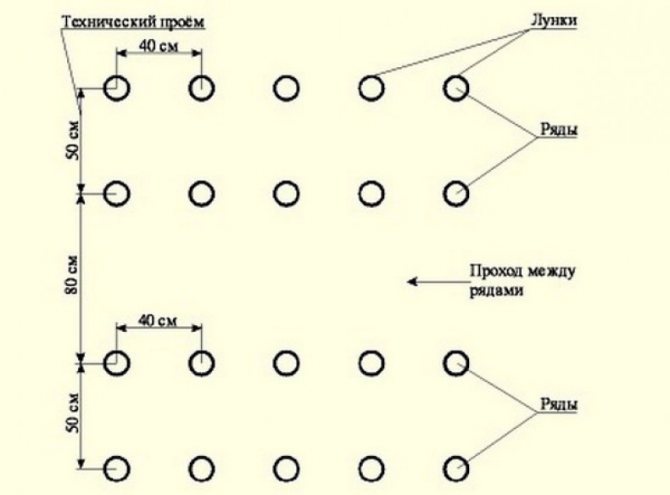

In greenhouses, it is convenient to use a two-line planting scheme.
Tomato care
The Altai masterpiece variety is generally unpretentious. Some inconveniences are associated with the need for pinching and shaping, but this is a common property for all indeterminate tomato varieties.
Plant formation
When forming a bush, all stepchildren that appear in the leaf axils are regularly removed. It is better to do this when their size does not exceed 5-7 cm. At the same time, the stepsons are not yet coarse and it is easy to pinch them off with their fingers. This procedure should be carried out regularly, avoiding thickening of the bushes, which, in turn, leads to a decrease in yield. In the open field, stepchildren are cut off at intervals of 7-10 days, and in the greenhouse they do this more often - every 5-7 days.
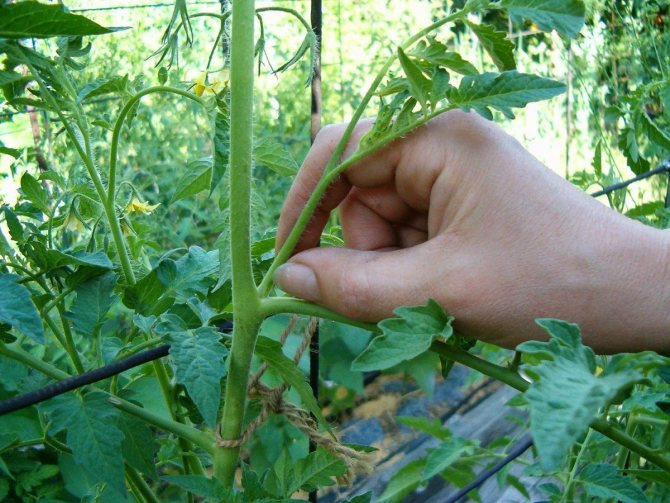

In the open field, stepchildren are cut off at intervals of 7-10 days, and in the greenhouse they do this more often - every 5-7 days
If they want to lead the plant in two trunks, then one stepson is left for its development, which is below the first brush. With the onset of fruiting, all the lower leaves are gradually removed up to the first brush or forks of the stems, which contributes to good ventilation and illumination of the bushes. And of course, the plants need to be tied to stakes or hanging cords.
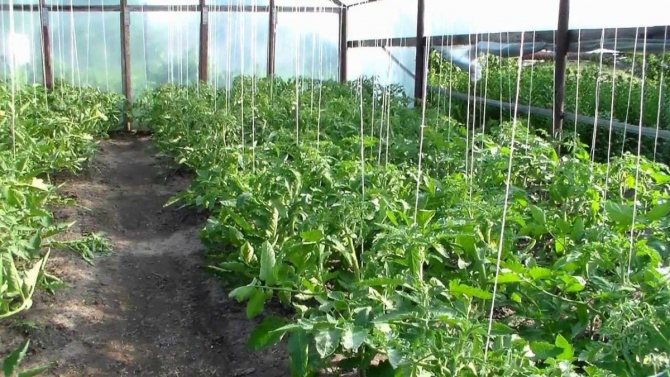

It is convenient to tie tomatoes to hanging cords
Watering
The Altai masterpiece tolerates drought well, but one must not forget about the peculiarities of its moisture. Immediately after transplanting the seedlings into the ground (open or closed), it is watered once and then do not give it water for 2-3 weeks. Due to this, the roots will tend to seek moisture in the depths of the soil and, thus, grow. In the future, watering is carried out not at the root, but in grooves located at a distance of 15-20 cm from the trunk. This also contributes to the development of the root system and an increase in the growth force of the bush. With the beginning of fruit setting and their growth, watering should be carried out regularly at intervals of 5-7 days, while waterlogging and waterlogging should be avoided.
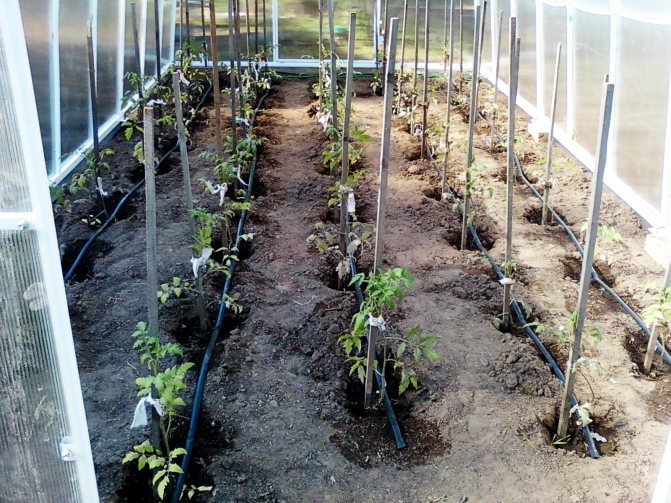

It is convenient to irrigate tomatoes using drip irrigation systems
Top dressing
To ensure decent yields, Altai masterpiece tomatoes need regular feeding. In this case, it is worth giving preference to organic infusions, which are easy to prepare yourself. To do this, you can use mullein, chicken droppings or just freshly cut grass (weeds from the garden are also suitable, but nettle gives the best effect). They are placed in a barrel with a wide neck and poured with water in a ratio of 1: 1, and then infused for 5-7 days. Then the infusion is filtered and diluted with water in proportions of 1: 5 (chicken manure infusion - 1:10) and one liter is poured under each bush. Such dressings are carried out during the growing season with an interval of 2 weeks. In between, it is desirable to apply potassium fertilizers (10-20 g of potassium monophosphate per 1 m2).
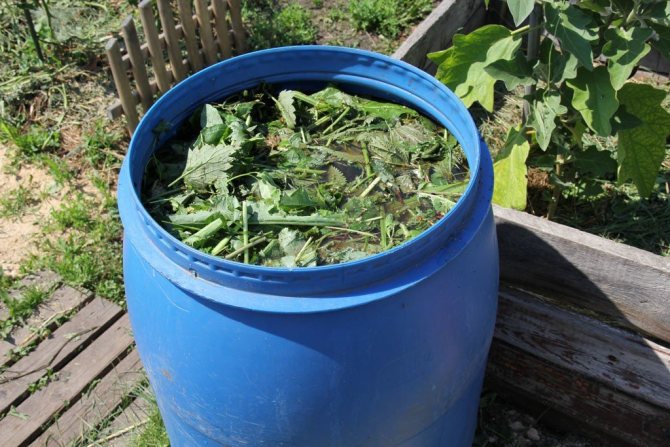

An excellent organic tomato fertilizer can be made with regular grass
Characteristic features of the variety
Having knowledge of valuable agricultural practices, you can achieve an exceptionally good harvest from the bushes of the Altai Masterpiece variety, this mid-season tomato. Its fruits ripen 110-120 days after germination, usually in early or mid-August.
- Ripe tomatoes are distinguished by their uniformity and the fact that the berries on this powerful bush amaze with their incredible size. On each cluster, the fruits are very large, and not only on the lower ones, as is often the case with tomatoes of this type.
- The fruits of these tomatoes are indicated by the originators of the variety as salad. This means that the red berries of the plant fully reveal their harmonious taste in fresh salads.Of course, with a large harvest, slices are prepared from them in the phase of incomplete maturity for various canned blanks. Delicious juices or sauces come out of fully ripe berries saturated with thick pulp;
- Due to the density of the pulp, tomato fruits tolerate transportation well, they remain indoors for quite a long time;
- This is a non-hybrid tomato plant: gardeners choose seeds from fruits for further reproduction;
- A characteristic feature of the variety is the fast pouring of the fruit. Early tomatoes may already be fully ripe, but these bushes are just beginning to form berries. From the beginning of August, the plants are literally covered with large fruits that ripen in a short period.
Description of the variety
Each bred variety has a distinctive characteristic from others. "Altai masterpiece" can be described as follows:
- The bush is powerful and tall. Can grow up to 2 meters tall;
- The variety is mid-season. The crop ripens 110-115 days from the appearance of the first shoots;
- The leaves are large and light green in color;
- Brushes are formed over 10 sheets;
- The inflorescence of the plant is simple;
REFERENCE: The variety is not a hybrid, so you can pick the seeds yourself in order to sow them next year.
- The peduncle has a characteristic articulation;
- The fruits are bright red in color with a dense skin. They have a flattened-rounded shape and ribbing. The average weight reaches 400 g, but there are record holders weighing 1 kg. The seeds are arranged in six chambers. The pulp is fleshy and aromatic. The taste of tomatoes is sweet and sour.
Diseases and pests: how to deal with them
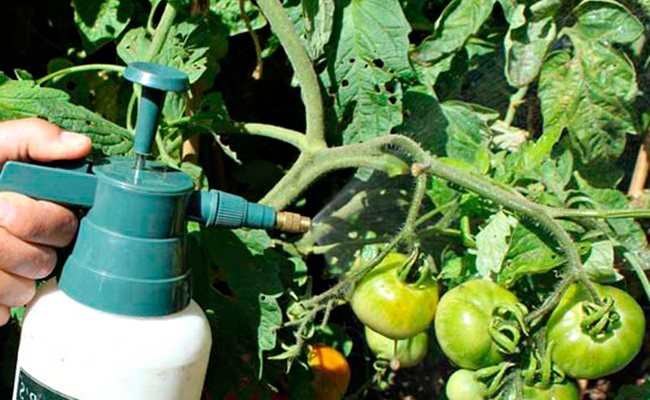

This variety is quite resistant to diseases, and it is also little affected by tomato pests. But in order to get an excellent harvest, prevention will not be superfluous, therefore:
- be sure to observe the crop rotation on the site;
- carry out pre-sowing disinfection of seeds;
- from about the end of June, tomatoes are treated with Bordeaux liquid and copper-containing preparations;
- do not allow high humidity in the greenhouse.
For treatments against pests, garlic infusion, soap compositions are used.
How to grow tomatoes
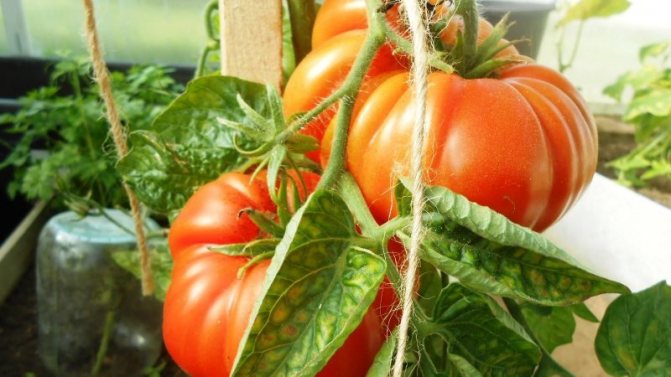

When the seedlings reach the age of 50-60 days, the culture is transplanted to a permanent place. The variety is resistant to low temperatures, so the plants thrive in the open field, where they bear fruit until the very frost.
Landing
For better development and crop yield, fertilizers are placed on the bottom of the holes before planting.
For this you will need:
- shovel of peat or sand;
- 1 kg of rotted manure;
- 0.5 l of wood ash.
With such a planting, the Altai masterpiece tomato is quickly accepted and restores damaged roots in a short time.
Care
Fertilizers are applied not only before planting in the holes, but also throughout the growing season. The first feeding is carried out two weeks after planting the seedlings in a permanent place. Then fertilize during flowering plants and again - in the midst of fruit ripening.
Tomato variety Altai masterpiece needs minerals for the formation of ovaries. Without fertilizers, the culture becomes weak and sick, and the ovaries fall off at the first stages of development.
The fruits of the variety do not crack, and the plant itself has good resistance to late blight, so the tomatoes are watered abundantly, but rarely. This option is suitable for summer residents who come to their plots only on weekends.
The bushes moisturize at the root in the morning or evening hours, when the sun is not beating down. After watering, the soil is loosened and at the same time weeds are removed.
Features of cultivation and possible difficulties
Growing tomatoes The Altai masterpiece is no different from the cultivation of other varieties. To obtain high yields, plants are fertilized in a timely manner. It is necessary to tie the branches to the supports in a timely manner in order to prevent them from breaking off.
Diseases and pests
Tomato Altai masterpiece practically does not get sick and grows well even in the wettest summer.The variety has resistance to late blight, Alternaria, root and fruit rot, which greatly facilitates the cultivation of tomatoes in the open field.
Although the variety is not susceptible to disease, vegetable growers still adhere to some rules for preventive purposes:
- the remains of vegetation are removed from the beds;
- weed the soil around the plants and get rid of weeds;
- observe the rules of crop rotation.
On a note. When growing tomatoes in greenhouse conditions, the room is regularly ventilated.
The resistance of the variety against tomato diseases allows it to be successfully cultivated in the open field. The main thing is to protect plants from pests.
Colorado potato beetle is disposed of by treatment with chemicals, for example, "Bankol", "Karate" or "Killer". Caterpillars, slugs and other creeping pests of bushes are scared off with wood ash or copper sulfate.
Tomato is a welcome guest on any garden bed. What other vegetable will add a delicious red color and fresh juiciness to summer salads? What can we say about conservation, without which no housewife can imagine her life. However, the abundance of tomato varieties can confuse even an experienced gardener. The best solution is to choose selected collectible varieties. For example, tomato Masterpiece. In the article you will learn the characteristics of this crop and the rules for its cultivation.
The authorship of the Masterpiece variety belongs to domestic breeders. Taking into account the climate of different regions of Russia, they set themselves the task of obtaining a universal variety. And they did it.
The masterpiece has the following characteristics:
- cold resistance;
- resistance to common diseases - late blight, root rot;
- mid-ripening - 120 days pass from the moment of germination to the first harvest;
- high yield - 3-6 kg per bush and 6-12 kg per sq. m, respectively;
- excellent taste - meatiness, predominance of natural sugar content over acids;
- good keeping quality and suitability for transportation;
- long shelf life - 3-6 months.
These indicators for gardeners differ slightly depending on agricultural technology, which is partly determined by the climate of the region.
Breeders took the trouble to create a whole collection so that it would be more convenient for amateurs to choose the right variety of tomatoes - Masterpiece Hybrid F1, Masterpiece Early or Masterpiece Altai. The most important indicator remains unchanged - high yield.
Other signs:
- medium-sized variety always forms many ovaries;
- fruits weigh 300-800 g;
- indeterminacy of tomato makes it possible to pinch or extend the bush in order to increase the ovaries.
Ripe fruits are distinguished by their flat-round shape, large size and pomegranate color. When cut and consumed, it turns out that the tomato is fleshy and sweet.
The masterpiece is a relatively young variety. But in just a few years of its spread, he managed to evoke responses from thousands of gardeners. Moreover, these responses are ambiguous.
First, about the good:
- suitable for growing in open and closed ground, which allows you to get an early harvest and grow in extreme conditions;
- divided into traditional varieties and hybrids for a simplified selection for personal requirements;
- unpretentiousness;
- excellent initial vegetative properties of the plant.
However, among the reviews, there are also disadvantages:
- unsuitable for canning whole fruits due to its large size;
- tying is necessary as the bush develops.
These disadvantages are conditional, because they apply to individual varieties.
The name of the tomato indicates early maturity. The variety is interesting for those who want to harvest 10-20 days earlier than usual. Growing seeds through seedlings is encouraged. In the process of development, an average number of dark green leaves grows on the bush.
The Early Masterpiece reaches a height of no more than 50 cm and produces medium-sized fruits weighing 120 g, up to 6 pieces per cluster. The yield from one bush per season is up to 5 kg.
In terms of application, the tomatoes of the Early Masterpiece can be safely called universal: for salads, tomato purees, blanks. Taste and preservation are at a high level.
This variety is in the greatest demand due to its tall growth and frost resistance. Hence the following advantages:
- resistance to viruses and fungi;
- high yield - up to 10 kg per bush;
- good marketability and taste of fruits weighing up to 600 g.
The predominantly indeterminate Altai Masterpiece is grown indoors so that the fruiting period is long. But if the tomato is planted in the southern region, you can do without greenhouses.
An advanced hybrid of the Masterpiece collection aims to set records. Therefore, gardeners must definitely appreciate:
- the suitability of growing in open-closed ground;
- average height - about 120 cm;
- resistance to diseases of nightshade crops;
- yield up to 12 kg per bush;
- the weight of one fruit is up to 1000 g.
The fruits of the F1 Masterpiece ripen in 100-110 days.
The growing season for all representatives of the Masterpiece tomato is the same, the seeds are grown in seedlings:
- In early March, when daylight hours increase, planting material is prepared - store soil or a mixture of peat, turf, ash (3: 4: 1).
- The seeds are disinfected in a manganese solution for 20-30 minutes, then soaked in clean water at room temperature for a day.
- The seeds that have hatched are planted to a depth of 1-1.5 cm, after which they are watered, and the earth is compacted (the depth of the general soil layer should be at least 4 cm, the sowing area is 30-50 seeds per 40-50 sq. Cm).
- When the first shoots appear (5-7 days after planting the seeds), the seedlings are exposed in a well-lit place without drafts.
- Every 5 and 20 days, seedlings are watered and fed with nitrogen-phosphorus fertilizers;
- On the 50-60th day, adult bushes are planted in the ground.
From this point on, the gardener should be guided by the growth rates of the Masterpiece. If the bush reaches 50-60 cm, it is suitable for planting in the ground. Medium-sized Altai Masterpiece and Masterpiece F1 oblige to prepare twines or trellises for garters.
These crops are preferable to grow indoors. The rest of the rules of agricultural technology are unchanged:
- Preparation of holes 20 cm deep for seedlings - peat, humus, ash (4: 1: 1) are added to each.
- Planting adult plants at a distance of 50-80 cm from each other and 1.0-1.2 m between the rows (when planting, watering with warm water is required, it is advisable to use Kornevin's solution so that the tomato quickly hardens in a new place).
- Watering every 5 days or as the soil dries.
- Weekly loosening for root ventilation and weeding.
- Tying up a plant when it reaches a height of 30-50 cm.
- Pinching stepchildren if necessary.
- Monthly top dressing with phosphorus-potassium or organic fertilizers.
The last feeding is carried out 2 weeks before the first harvest.
Attention! Spraying with nutrient solutions is best avoided as it has unpredictable effects on flowering and foliage.
Tomato Masterpiece is resistant to late blight and root rot. These diseases can develop only in open ground and with improper agricultural technology:
- with waterlogged air and soil;
- when pests appear.
Spraying the leaves with a solution of non-toxic biofungicides "Phytocid", "Trichodermin", "Mikosan" will help prevent an attack. They are processed in clear weather in a week from the moment the seedlings are planted, until the flowering has become massive. Re-spraying is allowed 3 weeks before harvest.
For pests, it is better to use bioinsecticides that do not poison bees and animals. Treatment type - spraying. The graph is the same as for biofungicides.
Oksana, 36 years old (Rostov-on-Don): “The climate of our region allows us to grow different tomatoes. But I still focus on the "giants". I tried to grow a Masterpiece Hybrid and received fruits weighing 1 kg. Children are delighted! "
Fedor Matyukhov, 47 years old (Cheboksary): “I want to contribute to public opinion about the Masterpiece. The variety is really frost-hardy and unpretentious. But for marketable products, it is better to use indoor ground and Early Masterpiece. I use the rest purely for collection (I grow more than 30 varieties). "
Nadezhda Viktorovna, 52 years old (Penza): “In all my life I have never seen such sweet and large tomatoes as in the photo in the magazine! I grow it in the open field, so some do not have time to grow before frost. It is necessary to plant the seeds at the end of February, so that in August it is possible to harvest in full, and leave the half-red fruits to lie in the sun until they are completely red. There are small tomatoes, and I can preserve them. Banks don't explode. The masterpiece is one of the best varieties! "
Tomato Masterpiece has met the hopes of breeders. The prevalence of this variety throughout Russia testifies to its positive qualities. However, the Masterpiece collection can be further developed to shorten the growing season and improve the tomato's resistance to the surprises of the northern climate.
a source
Tomatoes have long occupied pride of place on the tables and beds of vegetable growers and consumers. Tomatoes of the Masterpiece variety appeared thanks to the efforts of Russian breeders. Positive reviews secured the place of tomato among the popular plants for beginners and experienced gardeners.
To date, there are several types of tomato Masterpiece:
- Early masterpiece;
- Altai masterpiece;
- hybrid, masterpiece
The first is preferably grown in temperate and warm climates. The plant is suitable for cultivation in open ground and greenhouses. General characteristics:
- mid-ripening variety, berry ripening time up to 120 days;
- high yield, up to 5 kilograms of berries from a bush over the summer;
- undersized, height does not exceed 50 cm;
- medium foliage;
- leaves are small, dark green;
- the number of fruits in a cluster is up to 6 pieces;
- resistance to many nightshade diseases;
- long-term storage and transportation possible.
When ripe, the berry has a sweet taste and an average weight of 120 grams. It is one of the universal ones for use. Suitable for canning, pickling and fresh consumption.
The Altai species is also mid-season. Distinctive features include:
- tall, bush height up to 2 meters;
- cold-resistant;
- high yield, up to 4 kilograms per bush;
- resistance to most diseases;
- simple inflorescences;
- tolerates weather changes well;
- large-fruited, the mass of individual berries is up to 500 grams.
The variety belongs to the salad species. Ripe berries make an excellent ingredient for vegetable salads and tomato processing products: juices, pastes, sauces.
The third type Masterpiece f1 belongs to the late-ripening varieties, in all other characteristics it is similar to the Altai species.
All varieties of tomato Masterpiece prefer a seedling method of planting. You can get healthy seedlings by following a number of rules:
- plant seeds to a depth of 1.5-2 cm;
- after sowing, cover the containers with seedlings with foil;
- when the first shoots appear, move the plants to the windowsill or to a source of artificial lighting;
- regular watering.
IMPORTANT! Before planting, the seedlings must be hardened.
The features of agricultural technology of the Masterpiece variety have a number of general rules:
- watering with warm, settled water in the evening or morning as needed;
- fertilization of the soil with complex mineral fertilizer, at least 4 times per season;
- loosening the soil;
- regular weeding.
Altai tall variety needs tying and installation of supports. It is recommended to use one synthetic material for the garter. The formation of the bush should be carried out in 1-2 stems.
For a stunted species, experienced gardeners are advised to install supports under the branches in order to get a better harvest.
Good day! For residents of the northern regions, I recommend the Masterpiece tomato variety. The plant tolerates cold and extreme weather conditions well.The tomato shows resistance to a large number of nightshade diseases and unpretentious care. I did not find any minuses for myself.
Valentin Yagodkin, 43 years old.
I discovered the Altai Masterpiece tomato. The variety is very persistent and not capricious. Produces a decent harvest in cool, rainy summers. The berry is large, sweet and juicy. An excellent option for salads and pickles.
Arkady Novoselov, 47 years old.
a source
Tomato Masterpiece made all the farmers' dreams come true: unpretentious care, high yield, preservation of excellent taste after transportation. The tomato is suitable for regions with a temperate and warm climate for planting in open ground and greenhouses.
The plant was bred by Russian breeders specifically for areas where sharp temperature drops are possible for a short time. A decrease in humidity for a short period of time does not affect fruiting - this is one of the significant advantages of tomatoes in the conditions of a short and dry summer in central Russia. The F1 Masterpiece is described as having a number of virtues that have predetermined its culinary and commercial success.
- the taste of berries;
- optimal composition of trace elements and vitamins;
- accelerated maturation;
- compactness;
- versatility of application;
- resistance to major diseases;
- long shelf life.
The variety belongs to the determinate, that is, the undersized type of bush formation. The height of an adult plant reaches a maximum of 0.5 m. Thanks to the narrow crown and small leaf, you can save space in the garden, and especially in the greenhouse. Already 95 days after the emergence of seedlings, the first crop is harvested. This early maturity is characteristic of the determinant type grown in greenhouses. On the open ground, ripening ends within 4 months. One tomato weighs up to 100 g.
There are several varieties of tomato:
Each of them has its own characteristics, advantages and disadvantages. But they all ripen perfectly after harvesting under normal room temperature conditions, within +20 ° C. Tomatoes can be used to prepare salads, sauces, mashed potatoes and pastas. Berries fit perfectly in glass containers for preservation.
The best way to grow tomatoes is seedlings. The deepening of seeds begins after March 15 with preliminary treatment with growth stimulating substances. The variety, although not large-fruited, is picky about the quality of the soil, the amount of water in it, the presence of nutrients and trace elements. The plant responds well to the introduction of a small amount of superphosphate fertilizers. The main component of top dressing should be organic materials: humus and sod land.
After planting tomato seeds Masterpiece in moist soil, it is necessary to maintain an air temperature not lower than +23 ° C. Seed trays are covered with foil. After germination, it is advisable to illuminate the seedlings with artificial light using fluorescent lamps.
Several lamps will cope with this task if the seedlings are grown for personal subsidiary plots. Thinning of seedlings should be carried out in the presence of 1-2 true leaves. After diving, the plants are fed with liquid nutrient mixtures.
Young shoots must be hardened 2 weeks before transplanting. To do this, they are taken out into fresh air for 15-20 minutes. After 10 days, the hardening time increases to several hours. At the end of the third month after planting the seeds, in good weather outdoors, the seedlings are transferred to a permanent place of growth.
The soil is pre-mulched with humus, wood ash is introduced into the holes. The planting scheme provides for maintaining the distance between plants up to 50 cm.
Watering should be abundant, but not frequent. The water is used warm and settled. During fruiting, up to 4 root dressings are carried out. Foliar fertilizer mixtures can be sprayed onto the plant.
Reviews of gardeners indicate that a significant advantage of the Masterpiece tomatoes is their massive ripening before the onset of the late blight epidemic, which eliminates the need for preventive treatments.
To prevent apical or root rotting, it is necessary to carry out weeding, mulching with re-ripe straw and loosening the earth. Experts advise to perform soil cultivation with Fitosporin.
a source
Tomato Masterpiece: characteristics and description of the variety, reviews, photos, yield, advantages and disadvantages
The following are photo of tomato varieties Masterpiece:
This variety of tomatoes has its own advantages, among which the main ones can be distinguished:
Watch the video! Tomato variety Masterpiece
Below are the reviews those who planted tomato masterpiece... After reading them, you will understand all the advantages of the variety and the secrets of its cultivation.
Oksana, Perm
Elena, Kostroma
Svetlana, Kazan
Lana, Chelyabinsk
Tatiana, Mendeleevsk
Irina, Ufa
Tatiana, Kemerovo
Svetlana, Moscow
Galina, Izhevsk
If the article was helpful, please rate it with 5 stars!
a source
Relatively recently, the wide Russian market for tomato seeds has been filled with varieties of Siberian selection, including the already well-known Altai Masterpiece tomato. The main attraction of the whole variety of these varieties is the ability to give a high yield in adverse weather conditions. This tomato variety was entered in the State Register in 2007 and has become popular not only in its homeland, in the Siberian climate, which is characterized by severe weather events. The plant's resistance to rainy summers and low temperatures, along with excellent taste characteristics, were noticed and appreciated by gardeners of the middle zone of the country.
Knowing the advantages and negative characteristics of any variety, it is easier to determine whether they are suitable for growing in a particular environment. The Altai Masterpiece tomatoes have many advantages, judging by their description.
- The yield of the bushes of these tomatoes, subject to all the requirements of agricultural technology, can reach 10 kg of the total harvest of fruits from one square meter. In country gardens, in the beds in the open field, lovers of growing their own vegetables are guaranteed to collect 3-5 kg of fruits of this tomato per 1 sq. m. In the greenhouses of experienced gardeners, the yield rises to 7 kg. This data is taken from various reviews on the forums;
- The taste quality of large, pretty and mouth-watering tomato fruits is very high;
- The attractiveness and marketability of the Altai Masterpiece tomato fruits, according to the reviews of those who feasted on them, deserve praise from both sellers and all buyers;
- The resistance to cracking of the skin of a large tomato fruit is also highly regarded when marketed, as well as in normal household consumption;
- Strong tomato bushes of this variety are distinguished by a long fruiting period, which begins in August and lasts until the end of October under greenhouse conditions;
- The original immunity to diseases makes this variety of tall tomatoes a favorite of gardeners, since it resists pathogens of fungal and viral diseases both in a greenhouse and in ordinary open beds;
- Resistance to low temperatures.
Even such excellent qualities may not please those gardeners, for whose reviews the Altai Masterpiece tomato variety has drawbacks. They all boil down to the fact that a powerful tomato bush requires a little care for itself in exchange for delicious huge fruits.
- Tall plants of Siberian tomatoes fully realize their potential in spacious, almost two meters high, greenhouses;
- To obtain the fruit size characteristic of this variety of tomatoes, it is necessary to regularly pinch the plants;
- The size of the fruits of this variety does not allow them to be preserved whole.
Indeterminate non-standard tomato bushes Altai Masterpiece, as described in the descriptions of gardeners who planted them, grow even more than two meters.It is necessary to stop the growth of the bush of these powerful plants by pinching the top. The most acceptable height of this tomato bush is 1.5 m in open beds and 1.8 m in greenhouses.
The stem of a tomato bush of this variety is powerful, thick, gives many stepsons. The branches are equally strong, capable of carrying a significant load from several heavy fruits. Leaves are light green, large. Clusters with flowers begin to form at the top above 10 or 11 leaves. Then they regularly appear through every third sheet. The plant has a simple inflorescence. The stalk is characterized by articulation.
The bright red, ribbed fruits of these tomatoes, as seen in the photo, have a rounded, flattened shape. Before ripeness, the fruits are light green, with a darker spot around the stalk, which disappears at maturity. Fruits of tomatoes of this variety weigh from 200 to 400 g. If all agrotechnical requirements are observed, one fruit can reach a weight of 500 g. Record specimens of these tomatoes grow in greenhouse conditions - up to 1 kg.
The pulp of a tomato is of medium density (dry matter - 5-6%), fleshy, juicy, aromatic. Each fruit has six seed chambers. The tomatoes taste pleasant, delicious, sweet and sour. The skin of the fruit is also dense, does not crack.
Having knowledge of valuable agricultural practices, you can achieve an exceptionally good harvest from the bushes of the Altai Masterpiece variety, this mid-season tomato. Its fruits ripen 110-120 days after germination, usually in early or mid-August.
- Ripe tomatoes are distinguished by their uniformity and the fact that the berries on this powerful bush amaze with their incredible size. On each cluster, the fruits are very large, and not only on the lower ones, as is often the case with tomatoes of this type.
- The fruits of these tomatoes are indicated by the originators of the variety as salad. This means that the red berries of the plant fully reveal their harmonious taste in fresh salads. Of course, with a large harvest, slices are prepared from them in the phase of incomplete maturity for various canned blanks. Delicious juices or sauces come out of fully ripe berries saturated with thick pulp;
- Due to the density of the pulp, tomato fruits tolerate transportation well, they remain indoors for quite a long time;
- This is a non-hybrid tomato plant: gardeners choose seeds from fruits for further reproduction;
- A characteristic feature of the variety is the fast pouring of the fruit. Early tomatoes may already be fully ripe, but these bushes are just beginning to form berries. From the beginning of August, the plants are literally covered with large fruits that ripen in a short period.
Tomatoes of the Altai Masterpiece tomato variety are propagated by gardeners in a seedling method. Seeds must be sown two months before planting in a permanent place.
Altai Masterpiece tomato seeds are sown to a depth of 1-1.5 cm in early March, if the plants are placed in a greenhouse. For garden planting, sowing is carried out a little later. You need to focus on your own conditions. If the seedlings are placed in a sunny corner, they can be sown in early April. When two true leaves develop on the sprouts, they dive.
The seedlings are transferred to greenhouses from the beginning of May, to open ground - from the second decade of May to mid-June, protecting them from direct sunlight and frost with non-covering material. With the threat of low temperatures, they create an additional cover made of film Typically, tall tomato seedlings are arranged in a 50x40 pattern.
- Watered with warm water in the evening, and in greenhouses - only in the morning;
- Loosening is imperative so that the air penetrates to the roots, and at the same time weeds are destroyed. Weed plants need to be disposed of, because pests often develop on them;
- When pinching, you need to be careful not to cut off the entire branch. Otherwise, the stem of the plant will be injured, it is better to leave the stumps up to 1 cm;
- Tomatoes are fed 3-4 times during the growing season.
- Tomato bushes Altai Masterpiece are sure to stepchild, tie up or install props;
- When climbing plants, it is necessary to leave 4-6 leaves above the uppermost inflorescence;
- Many gardeners keep the bushes of these tomatoes in one stem. Although the plants bear fruit quite well, if formed into two or even three stems. To get the second stem, leave the stepson that grows under the first brush;
- On plants below the first brush, leaves are removed to improve air exchange and more access to sunlight to the fruits;
- To form larger fruits, gardeners tear off small or ugly flowers on their brushes.
Simultaneously with this famous variety, a real masterpiece, Barnaul agro also offered Altai red, Altai pink, Altai orange varieties. They are similar in agricultural technology and qualities, but there are also distinctive features.
a source
This tomato belongs to the super-large-fruited tomato series.
The subject of our special care is super-large-fruited tomatoes with fruits weighing up to 500 g and more. These are the tomatoes that every gardener dreams of.
The price is for 12 pcs. tomato seeds.
On this page of our online store you can order tomato seeds by cash on delivery. Seeds are shipped without prepayment. Payment for the ordered seeds takes place at the Russian Post office upon receipt.
INDEPENDENT TOMATO
(no growth restriction) hybrid.
IMPORTANT: WHEN WORKING, COMPLY WITH ALL MEASURES FOR DISINFECTION of containers (boxes, seedling glasses and bowls), work with gloves. Gloved hands or wash periodically or wipe disinfection. napkins. It is very common when the infection gets on the seeds due to insufficiently carefully processed containers. My new container is obligatory. Wash the used container and soak 2 tablets per 10 liters of water in DEO CHLORINE solution for a day, then rinse thoroughly.
DATE of sowing for seedlings from March 15 - 20 - March 30 - April 5 45 - 55 days (maximum 60 days) before planting seedlings in the ground (greenhouses). The closer to the bright and warm spring days you sow the seeds, the higher the solar activity. All phases of seedling development pass quickly. IMPORTANT ! The later you sow the seedlings, the faster and more actively they will grow. Seedlings sown from April 1 to 10 by the time of planting in the ground will not differ much from seedlings sown on March 15 or earlier sowing. PRIMING. 35% peat, 20% purchased high-quality soil with fertilizers and microelements, 30% steamed to 60 ° T 60 ° vegetable garden land not from under tomatoes, 10% own or purchased vermicompost, 4% perlite, 1% vermiculite.
Sowing seeds. In seedling containers, at the bottom of which drainage from charcoal of a fine fraction, pour 5 - 7 cm of well-mixed seedling soil. Level the soil. At a distance of 3 centimeters from each other, make grooves 1 cm deep. Moisten the soil with induced grooves from a spray bottle with a weak solution of potassium humate with microelements. Arrange dry hybrid tomato seeds in the grooves according to varieties, slightly pressing them into the ground with a finger pad or a toothpick at a distance of 2 - 2.5 cm from each other. Once again, lightly spray with a solution of Humate (humate + 7 or humate + iodine) from a spray bottle (stimulates and accelerates growth processes). Fill on top with DRY soil with a layer of 0.5 cm. Carefully compact the top layer of soil (press against the main one). Cover the seedling containers with foil to create a greenhouse effect and remove to a WARM place with T 28 - 30 ° C. Hybrid tomato seeds are more demanding for heat during germination, in contrast to varietal ones. If the temperature is not observed, the seeds may rot and not germinate or will germinate slowly and for a long time. When shoots appear, after 4 - 7, (maximum 10) days, remove the film and place the tomatoes under round-the-clock illumination for 3-5 days. With the emergence of seedlings, the temperature for the first two to three days is reduced to plus 15-18 ° during the day and 10-12 ° at night. This technique protects the seedlings from stretching and creates conditions for better development of the root system.Daylight hours for tomatoes are set at least 14-16 hours a day under illumination or on a light and warm, where there are no drafts, a windowsill. A week after germination, the temperature regime is changed to plus 20 -25 ° during the day and 12 - 15 ° at night. After 2 weeks from germination, seedlings are dived into individual seedling containers.
PICKING hybrid tomato. In a 400ml glass (bag) with drainage holes on the bottom pour a drainage layer of fine charcoal with a layer of 2 cm. You can grind the charcoal for barbecue, which is sold in all stores. Pour 1/5 teaspoon nitrogen-free complex fertilizer BOROFOSKA on the bottom of the seedling glass. It is phosphorus, boron and potassium that will participate in the laying of the first brush. Fill the seedling glass halfway with soil. Take out the seedling from the school with a teaspoon and transfer it to the seedling glass. Fill the roots completely with soil, carefully squeezing the soil in order to prevent the formation of air pockets without soil. Water the soil with a weak solution of calcium nitrate ½ teaspoon per 1 liter of warm water. Top up with soil and do not water. Place the seedling containers on pallets and place them under lighting. The next watering after the pick is carried out in 5 days until the earthen coma is completely wetted. Further watering is carried out only after the earthen coma has completely dried out. If the plants wither slightly, it is recommended to spray them with a weak solution of potassium humate or a weak solution (1/3 of the recommended dose) with a full-fledged mineral complex for tomato seedlings, but do not water until the earthen coma is completely dry.
During the growth of the seedlings, it is recommended to spray it on the leaf with calcium nitrate 1 - 3 times, normally 1 teaspoon per 1 liter of warm water. With the emergence of seedlings, the temperature for the first two to three days is reduced to plus 15-18 ° during the day and 10-12 ° at night. This technique protects the seedlings from stretching and creates conditions for better development of the root system. Daylight hours for tomatoes are set at least 14-16 hours a day under illumination or on a light and warm, where there are no drafts, a windowsill. Before disembarking, our seedlings must be HARDENED. To do this, for several hours, you need to reduce daytime temperatures to + 13 ° - + 15 °, night temperatures to + 6 ° - + 8 ° degrees. After 50 - 60 days, our seedlings are ready for transplanting to their PERMANENT RESIDENCE.
AGROTECHNICS of planting a hybrid INDEPENDENT tomato for permanent residence. Garden bed preparation. In the spring, mineral fertilizers are applied to the planting site of hybrid tomatoes. At the rate: PER 1 SQ.M: - add: 60 g of superphosphate, 60 g of potassium SULPHATE and 40 g of AMMONIUM SULPHATE (which contains sulfur + nitrogen, sulfur protects against ticks and diseases). The applied fertilizers are loosened with the soil. IMPORTANT. It is possible to plant tomatoes in the ground provided that the temperature of the GROUND in the ridges is above plus 12-14 degrees.
1. It is necessary to prepare the landing grooves, it is more convenient than preparing each hole individually. We prepare furrows 20-25 cm wide and 15-20 cm deep. If you plant in several lines and your beds are wide, then the distance between the planting grooves should be at least 70 cm.
2. 2-3 days before planting along the entire length of the planting groove, apply nitrogen-free fertilizer BOROFOSKA (long-acting fertilizer slowly dissolves all summer under the influence of soil acids and soil friendly microorganisms) at the rate of 2 spoons per running meter of the groove and mix with the soil.
3. We shed the grooves with Trichodermin VERIDE solution or BAIKAL solution or FITOSPORIN solution.
4. IMPORTANT. Trichodermin + Baikal = combined complex. FITOSPORIN + BAIKAL = combined complex.
5. DO NOT recommend combining phytosporin and Trichodermina Veride in the same area.
After spilling the grooves, cover them with handy material for 2-3 days before disembarking, to preserve moisture. When landing in landing holes, 20 - 30 cm deep.2 tablespoons of Borofoski are added to each well, mixed with the soil and spilled with a solution of Trichodermin + Baikal or a solution of Fitosporin + Baikal. Then the wells are also covered from moisture evaporation. It is better to land on a cloudy day. It is not recommended to water the tomatoes for 2-3 days before planting. BEFORE planting, the grooves (holes) are plentifully spilled with warm water, taking into account the fact that the next watering will be only after 10 days. Seedlings of indeterminate tomatoes are laid out in the planting grooves at a distance of 40 -50 cm from each other.
Carefully remove each seedling from the seedling glass. They are laid in the groove with the roots to the SOUTH, with the crown to the NORTH, preferably at an angle of 45 °, while the roots should be located slightly below the crown. Part of the excavated soil is used to backfill the roots of tomatoes. The soil is pressed to the roots very carefully. Avoiding the formation of air spaces. Once again, pour on the soil from a watering can through the "shower" nozzle with a solution of calcium nitrate at the rate of 1 tablespoon per 10 liters of warm water. The watered tomatoes are covered with the remaining dry soil. The top is no longer watered. Visually, it looks like the tomatoes are planted in DRY soil. Usually, with the next sunrise, the tomatoes are already raising their tops and taking a horizontal position.
Agrotechnics of care hybrid indeterminate
tomato in the ground (greenhouse). The first watering - feeding the hybrid tomato after planting in the ground is carried out exactly 10 days after planting. For this fertilizer AMMONIUM SULPHATE, which contains sulfur as prevention of diseases and nitrogen as a source of building material for building new plant cells, dilute 1 - 2 tablespoons in 10 liters of water and water the plants NEARBY with a groove along the entire perimeter of the garden. At the rate of 2 - 4 liters per plant. The amount of watering depends on the air temperature. The hotter it is outside, the greater the consumption of the solution during watering - 4 liters.
10 days after planting, the tomato is completely rooted in the soil and the growth of the root system and the aerial part begins. TOMATO must be tied up 10 days after disembarking in the ridge. 10 days after planting, the plant begins to form. To obtain the largest possible fruits, an indeterminate tomato is formed strictly IN ONE STEM, all growing stepchildren are removed. The STEAM of a tomato is a vegetative (daughter) process growing on a tomato stem from the place where the tomato leaf is attached to the tomato stem. The stepchildren break out early in the morning, when their length reaches 5 cm. From these 5 cm they break off 2 cm, and a stump of 3 cm length remains on the tomato trunk. This action is called - "breaking the stepson on a stump" or pinching on a stump. The left stump does not allow the new stepson to grow out of this bosom for a long time. With the CORRECT nutrition of the tomato, its development will be correct. Indeterminate tomato forms 3-4 leaves and a flower raceme within ONE week. (all Indets have flower brushes going through 3 leaves). IMPORTANT! With proper feeding, after the appearance of color on 4-5 brushes, a full-fledged 100% ovary of the brush is already formed on the first brush.
The tomato plant is already big. It has already evaporated part of the nourishment introduced with the first irrigations and nourishment from the soil through the leaf apparatus. Since the amount of soil from which you can get food is LIMITED, we will FEED our hybrid tomatoes ourselves for a rich harvest of tasty and sweet fruits.
AGRICULTURAL FEEDING AND IRRIGATION of indeterminate tomato.
It is generally accepted that any vegetable has three periods of development. Period - START (seedling period), period - DEVELOPMENT (growth and formation) and the Final period (maturation and harvesting). I would like to add one more period, conditional, since during this period we no longer feed or water. The period of STORAGE of vegetables, (both tomatoes and others), how vegetables will behave in this period, how long it will last without loss of marketable qualities, directly depends on how correctly the vegetables went through the three previous periods. DEVELOPMENT goes on an ascending straight line upwards, which means that nutrition should also go on an ascending line. For a HYBRID tomato, each brush needs to be fed with a full-fledged mineral nutrition. This means that a hybrid tomato should receive nutrition once a week, in contrast to varietal ones, which need nutrition once every 10 -14 days.Many people are afraid of the phrase CALCIUM NITRATE, and this is just a source of calcium for our plants. Calcium is an important constituent (component) in the skeletal structure of every plant cell, it strengthens the plant cell walls. Strong cell walls of any plant minimize the appearance of diseases and attacks of pests on the plant. The ratio of calcium and potassium in fruits should be 1: 4, which means that 3 potassium is needed for one calcium supplement. How do I add food? The speed of food delivery to each plant cell directly depends on the method of feeding. The fastest delivery speed and the most complete assimilation of food is the FOOD by SHEET option. We stopped with you on feeding with ammonium sulfate and left behind the START period. We pass to the development stage and the first feeding at the DEVELOPMENT stage will be calcium on the leaf. We look at the dosage on a pack of nitrate, specifically for foliar dressings.
Calcium is absorbed for 2.5 - 3 days. We do not feed anything these days, if the tomato requires watering, we water it with clean water. 3 days after the calcium, for the full formation of the buds of the brush, we feed (POTASSIUM MONOPHOSPHATE) phosphorus + potassium. This is both a phosphorus and potassium supplement at the same time. Enough ½ - 1 (no slide) teaspoon per 10 liters of water and spray tomatoes and other vegetables and bushes. We work with POTASSIUM MONOPHOSPHATE fertilizer on a sheet. This is a nitrogen-free fertilizer and if your soil under the tomatoes is dry, you can add organic fertilizing with mullein with watering in a ratio of mullein 1 liter + water 20 liters, 2-3 liters for each bush. IMPORTANT! In this variant, the combination of liquid nitrogen top dressing under the root + phosphorus-potassium on the leaf, nitrogen will not push the tomato to fattening, but will be fully used by the plant to build new cells, and most importantly, nitrogen in combination with phosphorus will not go into the nitrate form. This means that your fruits will not accumulate excess nitrates. Phosphorus will not allow them to do this. After 3-4 days, during which nitrogen, phosphorus and potassium are assimilated, we feed with MAGBOR, a boromagnesium complex. It is necessary in order for all the buds to become an ovary and the ovary to fully develop. That is, we do not allow the color to drop and the ovary to dry out. The consumption of the drug is minimal, the benefits are enormous. It is enough to dilute ½ teaspoon in 10 liters of water with slightly acidified milk whey or citric acid, who does not have whey, and spray our plants. All plants in the garden can be sprayed with the food we prepare for tomatoes. After 3-4 days, we feed a complete nutritional complex with microelements. You can take any complex, the main thing is that it has a full complex of trace elements in its composition. These properties are possessed by: Zdraven aqua, Agricola, Fertika luxury vegetable, Ideal, BIOHumus aqua. Whey is rich in amino acids. If you are preparing any nutrient mineral or organo-mineral solution for irrigation or spraying, add only 200 ml of serum to 10 liters of water, thereby you will increase the effect and benefits of nutrition.
After feeding with a full-fledged complex fertilizer, after 4 -5 days we give POTASSIUM fertilizing on a leaf or at the root. You can use for this top dressing such fertilizers as: POTASSIUM nitrate, POTASSIUM sulfate, POTASSIUM KELIK, POTASSIUM HUMATE, KALIMAG. Consumption rates of the drug for root and foliar dressing CAREFULLY read the instructions for the drug .. and take half as much. You already know that if you slightly acidify the water, then this half is quite enough for you. With these dressings in the amount of 5 basic dressings, we have already fed 2-3 brushes. Next, you need to start again working according to the feeding scheme, starting again with feeding with calcium nitrate. This is how we work until the FINAL period. The final means that we will no longer force our tomato to form new buds, since we no longer need a new ovary.At the final stage, we completely exclude PHOSPHORUS and BOROMAGNESIUM as independent fertilizing. We replace them with top dressing with complete nutritional complexes. 10-15 days before the last harvest of our tomatoes, both red and green, which will go for storage and ripening, you need to do TWO last and very important feeding. Calcium nitrate, so that our fruits retain their firmness during storage and do not shrivel. After 3 days, HUMATE POTASSIUM or HUMATE + 7 or HUMATE + IODINE and only on the sheet. We no longer water the tomatoes. Watering is stopped 20 days before the end of the season. Calcium supplementation will keep the shape of our fruits when stored perfectly. Feeding with humate will protect our fruits from diseases and rot during storage. Will make our plants sweet and delicious.
TOMATO DETERMINANT hybrid with growth restriction ("self-perforating") AGROTECHNICS of growing seedlings.
Sowing time for seedlings: from 1 - 15 to 15 April 40 - 35 days (maximum 45 days) before planting seedlings in the ground. The closer to the bright and warm spring days you sow the seeds, the higher the solar activity. All phases of seedling development pass quickly. IMPORTANT! The later you sow the seedlings, the faster and more actively they will grow. As a rule, we prepare determinate varieties for planting in open ground, and it is not advisable to sow them on seedlings early. Otherwise, if the weather fails, the seedlings will simply outgrow and lose their quality.
PRIMING. 35% peat, 20% purchased high-quality soil with fertilizers and microelements, 30% steamed to 60 ° T 60 ° garden soil not from under tomatoes, 10% own or purchased vermicompost, 4% perlite, 1% vermiculite. In soil prepared independently with the addition of no more than 20% of the purchased one, hybrids grow better, as well as non-hybrids. Sowing seeds. In seedling containers, at the bottom of which drainage from charcoal of a fine fraction, pour 5 - 7 cm of well-mixed seedling soil. Level the soil. At a distance of 3 centimeters from each other, make grooves 1 cm deep. Moisten the soil with induced grooves from a spray bottle with a weak solution of potassium humate with microelements. Arrange dry hybrid tomato seeds in the grooves according to varieties, slightly pressing them into the ground with a finger pad or a toothpick at a distance of 2 - 2.5 cm from each other. Once again, lightly spray with a solution of Humate (humate + 7 or humate + iodine) from a spray bottle (stimulates and accelerates growth processes). Fill on top with DRY soil with a layer of 0.5 cm. Carefully compact the top layer of soil (press against the main one).
Cover the seedling containers with foil to create a greenhouse effect and remove to a WARM place with T 28 - 30 ° C. Hybrid tomato seeds are more demanding for heat during germination, in contrast to varietal ones. If the temperature is not observed, the seeds may rot and not germinate or will germinate slowly and for a long time. When shoots appear, after 4 - 7 days remove the film and place the tomatoes under round-the-clock illumination for 3-5 days. With the emergence of seedlings, the temperature for the first two or three days is reduced to plus 15-18 ° during the day and 10-12 ° at night. This technique protects the seedlings from stretching and creates conditions for better development of the root system. Daylight hours for tomatoes are set at least 14-16 hours a day under illumination or on a light and warm, where there are no drafts, a windowsill. A week after germination, the temperature regime is changed to plus 20 -25 ° during the day and 12 - 15 ° at night. After 2 weeks from germination, seedlings are dived into individual seedling containers.
PICKING hybrid tomato. In a 400ml glass (bag) with drainage holes on the bottom pour a drainage layer of fine charcoal with a layer of 2 cm. You can grind the charcoal for barbecue, which is sold in all stores. Pour 1/5 teaspoon nitrogen-free complex fertilizer BOROFOSCA on the bottom of the seedling glass. It is phosphorus, boron and potassium that will participate in the laying of the first brush.Fill the seedling glass halfway with soil. Take out the seedling from the school with a teaspoon and transfer it to the seedling glass. Fill the roots completely with soil, carefully squeezing the soil in order to prevent the formation of air pockets without soil. Water the soil with a weak solution of calcium nitrate ½ teaspoon per 1 liter of warm water. Top up with soil and do not water. Place the seedling containers on pallets and place them under lighting. The next watering after the pick is carried out in 5 days until the earthen coma is completely wetted. Further watering is carried out only after the earthen coma has completely dried out. If the plants wilt slightly, it is recommended to spray them with a weak solution of potassium humate or a weak solution (1/3 of the recommended dose) with a full-fledged mineral complex for tomato seedlings, but do not water until the earthen coma is completely dry. During the growth of DETERMINATE tomato seedlings, it is recommended to spray it on the leaf with calcium nitrate 1 time, normally 1 teaspoon per 1 liter of warm water. Before disembarking, our seedlings must be HARDENED. To do this, for several hours, you need to reduce daytime temperatures to + 13 ° - + 15 °, night temperatures to + 6 ° - + 8 ° degrees. After 35 -45 days, the seedlings of the DETERMINANT tomato can be planted for permanent residence. In this case, it is necessary to take into account the T of the soil in the ridges, it should be higher than + 12 °, as well as the likelihood of recurrent frosts. Therefore, the timing of disembarkation by region is individual. For some it is May 10th, for some it is only June 10th.
FAST METHOD of obtaining high-quality seedlings of DETERMINATE tomato WITHOUT PICKING. Fill the disinfected boxes with soil, the height of the soil is 10 cm. Make rows at a distance of 10 cm from each other, moisten the soil from a spray bottle with a solution of any HUMATE. Arrange the seeds in rows 10 cm apart. Spray lightly with HUMATE again. Cover the boxes with foil and take them out to the glazed loggia or to the greenhouse. On top, make a shelter from a non-woven covering material. When seedlings appear, remove the film. Leave the seedlings under the cover to protect them from night frosts and the bright daytime sun. IN NO EVENT DO NOT USE POLYETHYLENE FILM FOR A DAY as a covering material. In case of frost, it is recommended to put the film over the covering non-woven material overnight. Top dressing and watering in the same mode as in the option with a pick. With the planned landing on the street from June 1 to June 10, sowing in this way can be carried out in the period from April 20 to 25. IMPORTANT: Sowing the seeds of a DETERMINANOTE hybrid tomato is always done based on the timing of the proposed planting of seedlings for permanent residence.
AGROTECHNICS of planting a hybrid DETERMINANT tomato for permanent residence. The preparation of the planting furrows or holes is the same as for the INDEREMINANT tomato. The agricultural technique of planting a determinant tomato directly depends on what kind of determinant tomato you have.
IMPORTANT: WHAT ARE DETERMINANT TOMATOES:
SUPER determinant tomatoes
(the shortest 25-40 cm). In superdeterminant tomatoes, a short, compact bush is formed with 2-3 inflorescences on the main and lateral shoots. It does not take much time for the development of the vegetative part of the plant, the ovaries begin to form early, therefore these tomatoes are the earliest ripening, they give the harvest in unison. Fruit size is 30-50 grams. The height of such bushes is usually 25 - 40 cm. Ripening of ultra-early ripening tomatoes takes 80-85 days (the earliest -75-79 days).
Super determinant tomatoes are tomatoes with small and not very sweet fruits. The low sugar content in the pulp is due to the fact that these tomatoes grow in conditions of short daylight hours and even cold nights. A SUPPORT is not placed for such children, the bush keeps itself perfectly. Such children DO NOT PASSION. They can be used as decoration for flower beds and borders. These tomatoes are ideal for those who want to harvest quickly and without unnecessary hassle.They are planted at a distance of 30 - 35 cm from each other in a row and 45 - 50 cm between rows.
Determinant tomatoes
- from 40 cm to 100 cm. The growth of these tomatoes is limited to 4-6 clusters. The bush of this variety will be slightly larger than that of superdeterminate tomatoes. The second wave of flowering begins with the formation of fruits on the first ovaries. Fruits ripen in tomatoes of this group 5-7 days later than in superdeterminant ones - they belong to mid-ripening tomatoes. Their productivity and duration of fruiting is higher than that of early varieties. Before planting in planting holes or furrows, it is recommended to immediately put a support to which the plant will be tied in the future. These tomatoes already need pinching. How to pinch them? It is necessary to remove all stepsons and leaves before the first fetal brush. Above the fetal hand, all stepchildren are not removed, as in the Indians, but their number is regulated. In addition to the main trunk, it is recommended to leave another 2-3 of the strongest stepsons, it is on them that the main crop of tomatoes will be formed. It is recommended to plant them for uniform illumination and airing with a bush, at a distance of at least 40 cm in a row from each other and a distance between rows of at least 60 -70 cm a row from a row.
Standard tomatoes are determinant tomatoes.
STAMP determinate hybrid tomatoes form a bush on a thick, short stem, and they do not need pinching and bush formation. Their leaves are close to each other, the distance between the ovaries is compact. Such tomatoes always give a good harvest. The very concept of standard means that the crown of plants is very spreading and is literally hung with fruits, on short and strong thick peduncles. And they need to be planted very widely from each other, at a distance of at least 1 meter between the plants themselves and 1.2 - 1.5 s between the rows, since the nutrition area required for each bush is about 0.5 - 0.7 square meters. m for each plant. The whole feeding scheme during growth and development is the same as for INNTNRMINATE hybrid tomatoes.
AGROTECHNICS Semi-determinant tomatoes are the same as those of the Indetes. There is only one difference. HALFs bear fruit perfectly if they are led into TWO trunks. Semi-determinant are tall tomatoes up to 2 meters or more. Their inflorescences are laid every 2-3 leaves, more often after 2 leaves. Fruits ripen together and evenly throughout the growing season. Their internodes are shorter than those of INDES, the distance between leaves and ovaries is shorter.
HYBRID Beef-tomatoes are tomatoes with large fruits. Plants are powerful 80 - 120 cm high. Planting scheme, as well as standard tomatoes. The root system of Beef tomatoes is very powerful and spreading. Top dressing according to the scheme of hybrid tomatoes of indetes. A feature of beef tomatoes is that the amount of ovary in the brushes needs to be REGULATED. In total, you need to leave 3-4 fruits in the brush, pinch off the rest of the flowers. Then your BIF tomato will be really big.
a source
General information about tomato
To date, there are several types of tomato Masterpiece:
- Early masterpiece;
- Altai masterpiece;
- hybrid, masterpiece
The first is preferably grown in temperate and warm climates. The plant is suitable for cultivation in open ground and greenhouses. General characteristics:
- mid-ripening variety, berry ripening time up to 120 days;
- high yield, up to 5 kilograms of berries from a bush over the summer;
- undersized, height does not exceed 50 cm;
- medium foliage;
- leaves are small, dark green;
- the number of fruits in a cluster is up to 6 pieces;
- resistance to many nightshade diseases;
- long-term storage and transportation possible.
When ripe, the berry has a sweet taste and an average weight of 120 grams. It is one of the universal ones for use. Suitable for canning, pickling and fresh consumption.
The Altai species is also mid-season. Distinctive features include:
- tall, bush height up to 2 meters;
- cold-resistant;
- high yield, up to 4 kilograms per bush;
- resistance to most diseases;
- simple inflorescences;
- tolerates weather changes well;
- large-fruited, the mass of individual berries is up to 500 grams.
The variety belongs to the salad species. Ripe berries make an excellent ingredient for vegetable salads and tomato processing products: juices, pastes, sauces.
The third type Masterpiece f1 belongs to the late-ripening varieties, in all other characteristics it is similar to the Altai species.
Reviews about growing tomato
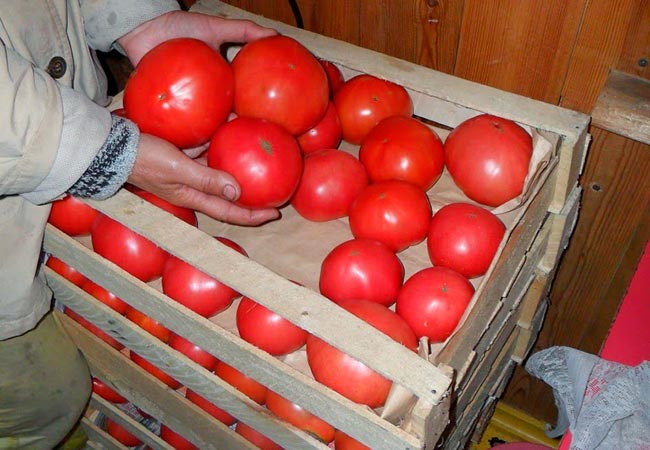

Although the Altai masterpiece tomato variety is recommended more for growing in Siberia, gardeners from other regions of the country have also successfully tested it. And everyone who planted it is unanimous in their reviews: an excellent, productive, not capricious variety.
They note such advantages as large-fruited, no less than that of the Mishka clubfoot variety, excellent fruit taste, unpretentiousness. Tomato tolerates temperature changes well, does not reduce productivity during a long cloudy period, and is not susceptible to disease.
In a word, a masterpiece is a masterpiece everywhere, both in Siberia and in the center of Russia. The main thing is proper care and care, and then you will be provided with a good harvest.
Natalia Severova
Farmers reviews
Tomato Altai masterpiece is gaining more and more popularity among vegetable growers. Summer residents prefer this variety for an impressive list of positive characteristics. Here are just some of the opinions of gardeners.
Svetlana, Rostov: “I have been growing tomatoes for about 10 years. One of my favorite varieties of tomatoes is the Altai masterpiece. The bushes grow to the ceiling of the greenhouse. Culture doesn't demand much attention. For the entire growing season, the plants never got sick, but several times carried out prophylaxis against insects. Harvested a lot. One tomato weighs on average 300-400 g. The fruits are beautiful, as in the photo, and most importantly, they are delicious. "
Sergey, Odintsovo: “The Altai masterpiece tomato variety was grown through seedlings, then transplanted into a greenhouse. The first fruits appeared at the end of July. There were a lot of vegetables, I didn't know what to do with it. I gave some to the children, and from the rest I made the winter harvesting of tomato juice. The whole family liked the variety. Next year I will plant tomato Altai masterpiece again ”.
Harvesting and application of the crop
The first fruits ripen four months after germination of seeds - in early August. Fruiting lasts until the first days of October. Vegetables are carefully picked and placed in boxes. This will preserve the fruits during long-term transportation or long-term storage.
Tomatoes are used for fresh salads, but with a large harvest in the phase of incomplete maturity, slices of various canned blanks are prepared from them. Fully ripened, thick-fleshed vegetables are used to make delicious juices or sauces.
Advantages and disadvantages
When planning to plant tomatoes in your summer cottage, consider their positive and negative sides.
Description of the advantages of this variety:
- high productivity;
- excellent taste of fruits;
- the fruiting period lasts until the first frost (from August to November);
- immunity to sudden changes in temperature;
- good pollination of plants;
- strong skin that does not crack and retains the neat shape of the fruit;
- attractive presentation;
- excellent customer demand;
- tomatoes tolerate transportation well and are well kept at home.
Negative reviews are due to the fact that a tall variety requires increased attention. Caring for the bushes involves tying up the plants, so you will have to spend a significant amount of time on this procedure.
Pros and cons
- Let's consider the main advantages and disadvantages of this tomato variety. The pluses include the following:
- unpretentious care and resistance to adverse conditions;
- pleasant sweet taste;
- long-term fruiting;
- no cracking of fruits during ripening;
- resistance to many diseases;
- high productivity;
- good transportability.
- With all the positive qualities of the Altai masterpiece, it still has some disadvantages, including:
- it is necessary to carry out pinching;
- because of the large size of the fruit, it is not suitable for preservation;
- large tomatoes can break off the brushes, so they need to be tied up.
Description and characteristics. Yield indicators
The authorship of the Masterpiece variety belongs to domestic breeders. Taking into account the climate of different regions of Russia, they set themselves the task of obtaining a universal variety. And they did it.
The masterpiece has the following characteristics:
- cold resistance;
- resistance to common diseases - late blight, root rot;
- mid-ripeness - 120 days pass from the moment of germination to the first harvest;
- high yield - 3-6 kg per bush and 6-12 kg per sq. m, respectively;
- excellent taste - meatiness, predominance of natural sugar content over acids;
- good keeping quality and suitability for transportation;
- long shelf life - 3-6 months.
Bush formation
As stated in the description, "Altai pink" tomato refers to tall varieties. Such plants need tying and shaping. It is best to keep the plant in 1-2 stems. In addition to pinching, it is necessary to remove all lower leaves before each ovary. As a result of proper formation, there will be 3-4 leaves on the bush, which will be quite enough for him to carry out photosynthesis and for nutrition. This formation provides better air and light access to the plant, and also helps to reduce the risk of fungal diseases. Formation helps to get an early bountiful harvest, since the removal of leaves allows the use of resources specifically for fruit formation.
In hot regions, it is not recommended to strongly remove the leaves, as they protect the fruits from sunburn and overheating. It is recommended to remove the leaves as the crop is harvested from the bush.
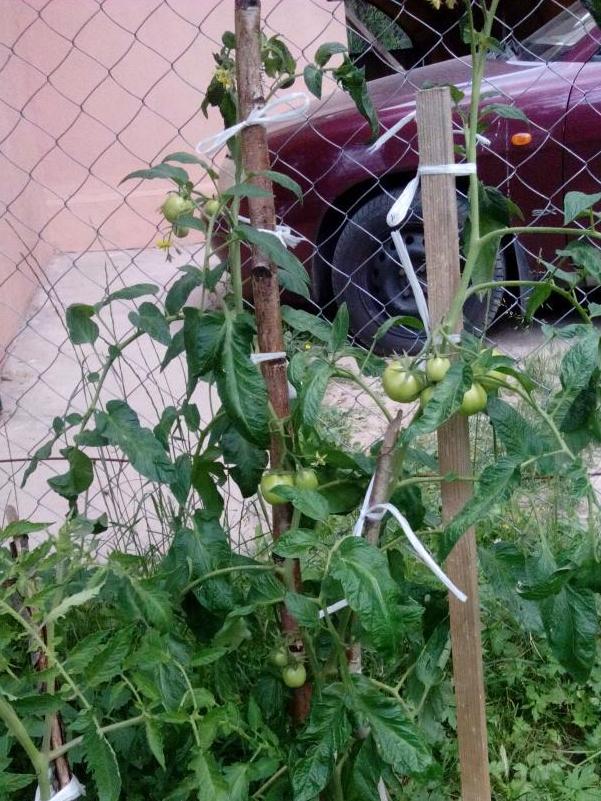

Growing conditions
Caring for the Altai masterpiece is the same as for all tomatoes:
- Watering
- Loosening and removing weeds
- Top dressing
- Garter
- Stealing
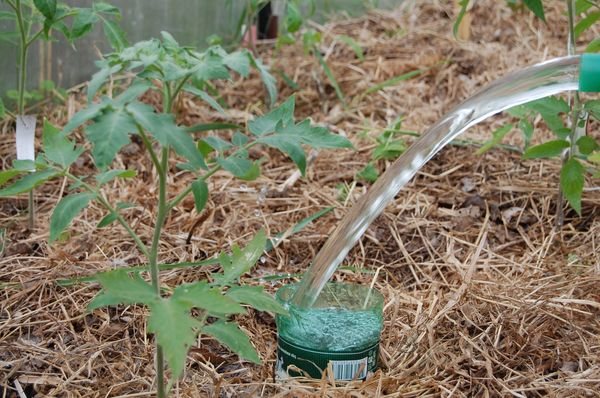

Watering is carried out exclusively with warm water
Watering is carried out with warm water, since cold water stops the development of the root system.
Both underfilling and overflowing are harmful to tomatoes. With an excess of moisture, root decay may occur and the plant will die. With a deficiency, poor fruit formation occurs. Tomatoes are watered exclusively under the bush, trying not to get on the leaves and stem.
Loosening is carried out after every watering... This is necessary to allow air to flow to the roots and prevent the formation of an earth crust. Weeds are removed as soon as they appear. Weeds carry with them a variety of diseases that lead to the death of the tomato bush.
Top dressing of tomatoes is carried out every 10 day mineral and organic fertilizers. Tomatoes can get sick due to oversaturation with nitrogen, potassium and phosphorus.
Since the plant is indeterminate, it must be tied up. Suitable for this: stakes (2-2.5 meters), trellises, cages and caps.
Garter needed:
- To make it easier to care for a tomato bush: spraying and watering
- To prevent laying fruits on the ground, protecting them from damage to tomato rot
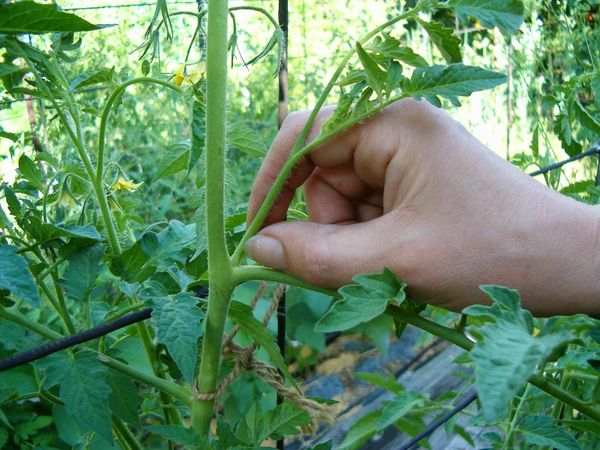

Removing stepsons is a mandatory procedure for the Altai masterpiece
Timely removal of stepsons, promotes the redirection of all nutrients to the formation of the fruit. This procedure is carried out with the first garter.
Stepchildren should not be removed at the very root, it is necessary to leave a stump of 1 cm. Stepchildren must be removed before the first inflorescence.
Fertilization
According to reviews, the "Altai pink" tomato, the photo of which is presented in the article, needs good feeding.From the period of picking seedlings to the beginning of flowering, it is necessary to carry out one complex fertilizing of plants. To do this, you can use mineral fertilizers or apply mullein.
After the first fruits are formed, fertilizer containing potassium is applied. For convenience, it is recommended to use mineral fertilizer granules that are mixed with the soil. Granules, being in the soil, dissolve for a long time, supplying the plant with the right amount of nutrients.
Gardening tips
- When growing seedlings, picking is required, since a thickened planting interferes with the good development of the plant.
- Seedlings need 14 hours of lighting
- To form a strong stem, a fan is placed next to the young seedlings to create an artificial wind
- Planting in a permanent place is carried out in warm soil. The degree of heating of the earth is checked by the presence of leaves on the birch. If they have blossomed, then the earth has warmed up enough
- It is necessary to plant tomatoes to a depth of 1/3 of the stem
- The beds need to be mulched. Mulch keeps the soil warm even on cold days
- To keep the tomatoes large and healthy, remove stepchildren and lower leaves
Planting seedlings should be carried out only in warm soil.
Humidity, temperature, light
For the successful development of tomatoes, an average daily temperature of 18-25 degrees is ideal. At lower temperatures, growth slows down, and at higher temperatures, the plants begin to burn.
Plants need direct sun only at the initial stages of flower formation, and during the flowering period and during the formation and ripening of fruits, tomatoes require heat.
The free movement of dry heat around developing tomatoes is the main condition for disease prevention. To ensure the movement of air in the greenhouse, it is necessary to ventilate it on hot days.
Useful Secrets
Simultaneously with this famous variety, a real masterpiece, Barnaul agro also offered Altai red, Altai pink, Altai orange varieties. They are similar in agricultural technology and qualities, but there are also distinctive features.
Characteristics
Compliance with agronomic rules will help to achieve an excellent harvest. The ripening period is 110-120 days after germination, most often in early to mid-August.
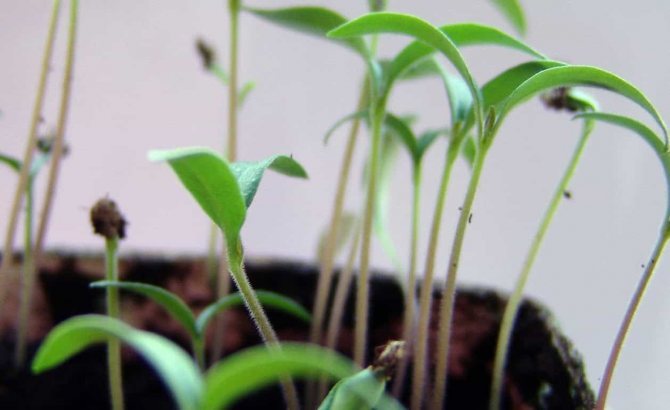

Characteristics:
- uniform ripening, large-fruited, all fruits are of the same size, regardless of their location on the bush;
- harmonious taste - it manifests itself well in salads, tomatoes are used in canning;
- resistance to transportation, storage - achieved due to the dense structure of the pulp;
- the possibility of using seeds for further reproduction;
- fast ripening of fruits.

